Chicago Dryer files patent infringement lawsuit vs. Jensen

CHICAGO — Chicago Dryer Co. filed a patent infringement lawsuit against Jensen USA Inc. and JensenGroup NV in U.S. District Court, Northern District of Illinois, on June 20, alleging that Jensen infringed on a patent for flatwork feeding machines.
Plaintiffs are Chicago Dryer Co., FinishTech Ltd., Stanley McCabe and McCabe Corp. FinishTech is the exclusive licensee of the patent in question, and Chicago Dryer Co. is sublicensed to practice the patent issued in 1996, according to the complaint. Stanley McCabe invented the device claimed in the patent.
In a prepared statement released during the Clean Show, Chicago Dryer Co. described itself as “the leader in cornerless feeder technology since launching its Edge line products in the 1990s.”
“The complaint alleges that Jensen has infringed and is infringing U.S. Patent No. 5,515,627 through solicitation and sales of products including the Jenfeed Express feeder,” the statement reads. “Chicago Dryer and its business partners take their intellectual property rights seriously and will vigorously protect them from infringement.”
When reached by phone June 26, Simon Nield, president of Jensen USA, said his company had no comment on the matter.



The plaintiffs are seeking a permanent injunction plus damages. ALN
By Bruce Beggs, editorial director
NEW ORLEANS — The 2013 edition of the Clean Show—officially the World Educational Congress for Laundering and Drycleaning—closed here Saturday, June 22, at the Ernest N. Morial Convention Center after three full days of exhibits, educational programming and afterhours networking opportunities.
Based on observation and comments from a sampling of exhibitors, the first two days of the show were the best attended and saw the greatest level of activity.

John Riddle, president of management firm Riddle & Associates, reported after Thursday’s opening day that attendance had already
reached the 10,000 mark predicted before the show.
Final attendance figures weren’t available as this issue went to press; Riddle said his staff would
need time to tally registrations and determine if the New Orleans show total exceeded the 11,200 who registered in Las Vegas in 2011.
Exhibition space in New Orleans was up approximately 8% from what had been bud-
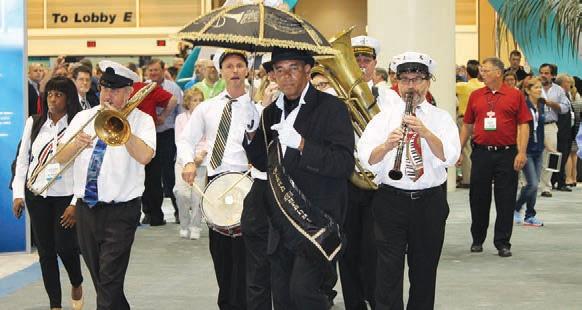

J uly 2013
Late News
www.americanlaundrynews.com Volume 39, Number 7 2013 clean show jazzes things up in New orleans iNside [4] [10] Panel of Experts Need to make a case for capital improvements? Three letters: ROI [14] Product showcase smallcapacity dryers See CLEAN on Page 6 Helping the Bottom Line Eric
suggests ways to increase linen life and save costs. Early attendance reaches 10,000; final total not available at press time
the Newspaper of record for laundry & linen Management
Frederick
After the ceremonial ribbon is cut, a band marches attendees onto the exhibit floor. Below, people line up in the convention center lobby as they wait to register on the Clean Show’s opening morning. (Photos: Bruce Beggs)
CHICAGO — Workplace safety remains a top priority among institutional and industrial laundry managers and administrators, based on data from June’s American Laundry News Wire survey.
For roughly 41% of respondents, it’s been more than 24 months since they last recorded a lost-time injury—a nonfatal traumatic injury that caused any loss of time from work beyond the day/shift during which it occurred—in their operation.
Only a small percentage (4.5%) have recorded a lost-time injury within the last 30 days, while other operations report having gone longer periods of time since their last such incident: one to six months ago, 18.2%; seven to 12 months ago, 13.6%; and 13 to 18 months ago, 9.1%. No one who responded to the survey reported having logged a lost-time injury 19 to 24 months ago.
Roughly 14% of respondents said they “don’t know” when the last losttime injury was recorded in their operation.
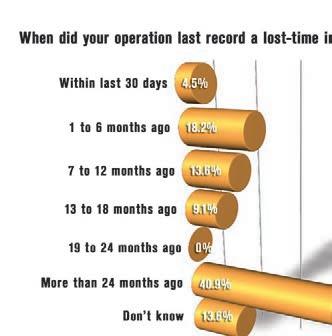
The vast majority of laundry managers and administrators polled—90.9%—report that they provide safety training/testing as part of a new employee’s orientation to their laundry/linen services operation, as well as continuing safety education or training for workers.
“Proper body mechanics and safety lock-outs are the most important things for us,” says one respondent to the anonymous survey. Another describes the structure of his/her workplace safety program, saying, “We have a corporate safety manager, and each plant has a safety officer.”
Have you ever sought assistance from a consultant or other knowledgeable industry resource to visit your plant and assess its safety? Only slightly more than one-third of respondents (36.4%) to the safety programs survey say they have sought such help to make their laundry/linen services operation safer.
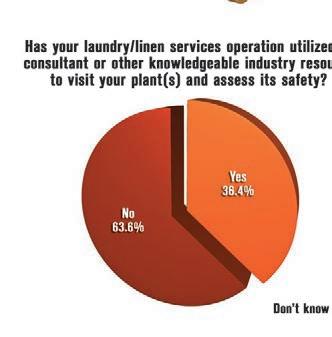
More than three-quarters of respondents (77.3%) say their operation has never been fined by a regulatory agency for a safety violation during their tenure. Roughly 14% have been fined, and 9.1% of respondents “don’t know” if they’ve been fined.
A blocked electrical panel was the nature of one violation that drew a fine. Another manager explained that his/her operation’s citation stemmed from having “no tool rest on a grinder.”
While the Wire survey presents a snapshot of readers’ viewpoints at a particular moment, it should not be considered scientific.
Subscribers to Wire e-mails—distributed twice weekly—are invited to take the industry survey anonymously online each month. All managers
Crown Uniform & Linen unveils plans to build new facility
BROCKTON, Mass. — Crown Uniform & Linen Service – Crown Healthcare Apparel Service will build a new 94,000-square-foot textile laundering and distribution facility here on Battles Street, the company announced June 26.
“The City of Brockton has greeted us with open arms,” says Crown President Chris Spilios. “Mayor (Linda) Balzotti and all the city officials have been most helpful in making this project a reality. This will be our first new modern plant, and we couldn’t be more excited that our opening will coincide with our 100th anniversary in 2014.”
The 20-acre site has been unused for many years, but will soon begin a developmental transformation that will result in a state-of-the-art facility.
“Crown is a great example of the industries we’ve worked hard to bring to Brockton, and it is one that we hope will thrive for generations to come,” says Balzotti. “I’m proud of our work with Chris Spilios and his team, and I’m looking forward to the day Crown breaks ground.”
Contractor Dacon Corp. of Natick, Mass., will build the plant in partnership with civil engineer John Holmgren, of J.K. Holmgren Engineering of Brockton. American Laundry Systems, Haverhill, Mass., will provide the process engineering services.
The Sustainable Business Leadership Program inspected and certified Crown’s South Boston facility, and will be working with Crown again to ensure SBLP certification at the new location. ALN
Publisher
Charles Thompson
Phone: 312-361-1680
E-Mail: cthompson@ americantrademagazines.com

Editorial Director
Bruce Beggs
Phone: 312-361-1683
E-Mail: bbeggs@ americantrademagazines.com
Digital Media Director
Nathan Frerichs
Phone: 312-361-1681
E-Mail: nfrerichs@ americantrademagazines.com
Production Manager
Roger Napiwocki
Contributing Editor Jean Teller
Editorial Assistant Carlo Calma
Advertising Sales
National Sales Director

Donald Feinstein
Phone: 312-361-1682
E-Mail: dfeinstein@ americantrademagazines.com

Office Information
Main Phone: 312-361-1700 Fax: 312-361-1685
Subscriptions 630-739-0600 www.americanlaundrynews.com
American Laundry News (ISSN 1091-9201) is published monthly. Subscription prices, payment in advance: U.S. & possessions, 1 year $39.00; 2 years $73.00. Foreign, 1 year $89.00; 2 years $166.00. Single copies: U.S. & possessions $7.00; Foreign $14.00.
Published by American Trade Magazines LLC, 566 West Lake Street, Suite 420, Chicago, IL 60661. Periodicals postage paid at Chicago, IL, and at additional mailing offices.
POSTMASTER, Send changes of address and form 3579 to American Laundry News Subscription Dept., 440 Quadrangle Drive, Suite E, Bolingbrook, IL 60440. Volume 39, number 6. Editorial, executive and advertising offices are at 566 West Lake Street, Suite 420, Chicago, IL 60661. Charles Thompson, President and Publisher. American Laundry News is distributed selectively to qualified laundry and linen management and distributors in the United States. No material appearing in American Laundry News may be reprinted without written permission. The publisher reserves the right to reject any advertising for any reason.
© Copyright AMERICAN TRADE MAGAZINES LLC, 2013. Printed in U.S.A.
MEMBERSHIPS
Association for Linen Management
and administrators of institutional/OPL, cooperative, commercial and industrial laundries are encouraged to participate, as a greater number of responses will help to better define operator opinions and industry trends.
Vast
of operators
top of safety programs 2 JULY 2013 | AMERICAN LAUNDRY NEWS www.AmericanLaundryNews.com INSIDE: [8] Textile Sourcing and Selection Global market changes continue to make textile sourcing and selection a challenge for textile services managers [9] Career Track [10] Panel of Experts When it’s time to make your case for capital improvements to administrators, be ready to talk return on investment [13] Tunnels Ease Workflow for Detroit Co-op A dual tunnel system has made life easier for Metropolitan Detroit Area Hospital Services and its member hospitals [14] Product Showcase: Small-Capacity Dryers [17] OPL 101: Choosing a Distributor Partner There are a few specific areas to keep in mind when vetting a potential partner, says Mark Hynes July 2013 • Vol. 39 | No. 7
ALN Survey:
majority
stay on

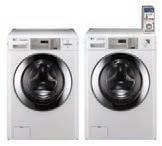

Back from the Big Easy
A
t this writing, just five days have passed since the 2013 Clean Show closed and my feet still hurt. What’s the old saying — no pain, no gain?
A little discomfort is certainly well worth the experience of walking the aisles of our industry’s largest trade show (for a seventh time) and meeting some great OPL managers, textile rental operators, coin laundry owners and dry cleaners amongst the massive displays and bright lights.
You’ll find our Clean Show Report in two parts. Part I this month covers show basics and
From The Director’s Chair BrUce Beggs
offers some photos from New Orleans. Part II coming in August will feature an expanded look at
the announcements, introductions and ideas that arguably made Clean ’13 a success.
This year’s show was shortened to three days. It remains to be seen if the “experiment” becomes the norm or we revert to the traditional four-day show two years from now in Atlanta.
I prefer four days to three so I have more time to see more exhibitors, but I understand the economics behind shortening the show.
No matter the final decision, I’m investing in some new insoles next time. ALN
ARCO/Murray begins construction on new Starr Textile Services plant
NEW ORLEANS — ARCO/ Murray recently started construction on a 63,500-square-foot hospitality laundry facility for Starr Textile Services, located here at 312 Timesaver Ave.
The new facility is being constructed to service the New Orleans hotel market and is scheduled to be completed later this year.
Starr Textile has experienced rapid growth recently and has outgrown its existing laundry facility on Magazine Street.

ARCO/Murray is retrofitting the existing warehouse space and providing a complete build-out to accommodate the new and relocated laundry equipment, including two tunnel washers, several washer-extractors, batch dryers, as well as pony washers and dryers.
All equipment is being provided by Pellerin Laundry Machinery Sales Co., the Milnor/Chicago Dryer Co. distributor local to New Orleans. Pellerin is also supplying the soil-side rail system, which is
manufactured by E-Tech.
The mechanical room equipment is being provided by Kemco Water Systems, Fulton Boilers, and Ingersoll Rand Air Compressors.
The project is scheduled to finish in time for Starr Textile to relocate its equipment and laundry operations from its existing facility and begin operations by the end of October.
ARCO/Murray’s Akshay Umashankar is project manager and Elliot Mata is project executive. ALN
Mission Linen Supply lands Black Oak Casino Resort hotel deal
SANTA BARBARA — Mission Linen Supply has been awarded a contract by The Hotel at Black Oak Casino Resort, the company reports.
Mission Linen’s Turlock, Calif., location will rent and supply a luxury line of bed linens and towels.
The hotel is also making a direct purchase of luxury blankets, monogrammed luxury bathrobes and embroidered towels, which it will sell to guests.
The Hotel at Black Oak Casino Resort is located in Tuolumne, Calif., and offers guests charm and
natural beauty, spacious rooms, wonderful décor, and hospitable staff, Mission Linen says.
Paul Medawar, the hotel’s general manager, indicated that Mission Linen’s expertise, service and product selection were all factors when choosing the supplier. ALN
need to lower costs? Try increasing linen life
The effects of sequestration were beginning to affect hospitals’ bottom line in June. Many facilities are actively looking for non-salary expenses that can be lowered. I would like to suggest some ideas to increase linen life, thereby reducing linen replacement costs:
Review each linen item with the endusers to make sure that it is the proper linen item for the intended use.
If a bath blanket is being used as a lift sheet, excessive tears in the item will develop. Are two patient gowns being used for each ambulatory patient to provide proper coverage?
Review your wash formulas to make sure you are obtaining proper levels of cleanliness, without excessively washing the linen.
Each classification should be washed in such a manner to keep rewash below 3% of total volume produced. High levels of alkalinity attack the cotton fiber and the finish on reusable barrier linen, as well as the soil. One key to longer linen life is to reduce the alkaline concentration of the wash formula.
Review procedures for determining proper sizes of wash loads.
Overloading will cause poor wash quality and excessive stains. I have seen laundries with excellent written procedures, but the normal daily practice did not resemble the written practice.
Carefully review all damaged linen to see if a pattern of abuse or product failure is evident.
Once a trend is discovered, corrective action can be taken to adjust product quality, construction and production technique, or improve in-service education with areas of use.
Check dryers to make sure they are operating correctly.
Excessive heat can damage linen and cause it to have a harsh hand. Door seals and interior air deflection blades should be checked to make sure everything is working properly. Poor seals that allow room air to enter the dryer without going through the burner area can cause artificially low outlet temperature readings, subjecting linen to higher-than-programmed temperatures.
Do not operate thermal fluid ironers at temperatures above 375 F.
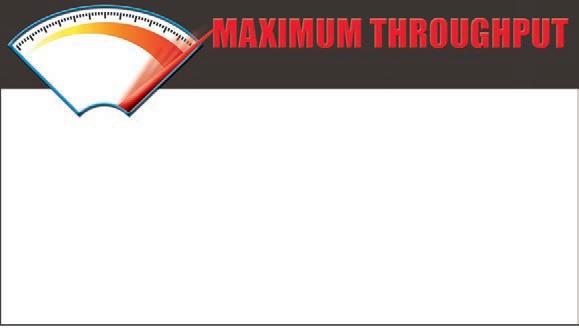
To iron at temperatures above this level will result in the loss of size stability in polyester fibers. Once heat-set, polyester fiber is no longer size-stable, so the laundry will experience higher-thannormal shrinkage. I have seen contour sheets that started out at 88 inches in length shrink to 76 inches. Avoid the temptation to iron at higher temperatures to increase productivity.
Marking linen with the name of the company or facility is no longer popular.
Buying groups are emphasizing lower-cost alternatives to name woven or marked linen. I still believe there are benefits to be had from boldly placing the name of the facility or company on the linen, either by having the name woven into the fabric or continuously applied at the mill. Small stamps placed in the corner of a sheet do little to increase the linen’s life.
Properly marking linen helps reduce loss in these ways:
1. It permanently, and obviously, indicates the owner of the linen and makes it easier to retrieve your linen from other facilities in your area when it leaves your facility during transfers or on ambulances.
2. It makes the linen less attractive to any person who might want to steal it and sell it.
Columnists/Features
•
•
•
•
•
•
•
•
•
•
•
•
•
From AmericanCoinOp.com:
•
3. It clearly identifies the linen as property of the facility and discourages honest people from taking it home. This is important in this day of disposable items that patients are encouraged to take home.
4. It provides undeniable evidence as to ownership, thereby making prosecution of thieves easier.
5. Name woven linen is abused less than non-name woven linen.
Reduce linen loss from the emergency room by stocking that area with other facilities’ linen, or downgraded linen that has been dyed and specially marked for that purpose.
efrederick@carilion.com.
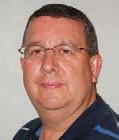
4 JULY 2013 | AmericAn LAUndrY news www.AmericanLaundryNews.com Top Stories Appearing on AmericanLaundryNews.com for the 30 Days Ending June 15 (WE) = Web exclusive news
Alliance Laundry Systems Restaging IPSO Brand for...
Crown Health Care Laundry Service to Open Mississippi Plant
Clean Show Expands Educational Programming to Include Afternoons
TCATA, DLI Teaming Up to Host Clean Show Bash in New Orleans
Restaurant Association Recognizes Value of TRSA Clean Green...
Survey: Respondents Show Lukewarm Interest in Laundry Accreditation...
Exclusive: 2010-2011 Textile Care Processing Cost Benchmarks
Going Industrial: Quality Linen Makes the Leap from Coin
California Hotel Breaks New Ground in Sustainability
Frederick: Clean Show Value Based on Willingness to Participate Fully our sister websites
AmericanDrycleaner.com:
From
Making the Decision to Raise Dry Cleaning Prices
Capitalize on Casual
Mountain Electronics Owners Honored as 2013 Entrepreneur...
Survey: Cleanliness is Fundamental to Coin Laundry Success
Columnist At lArge Eric L. Frederick, RLLD
ALN
Eric Frederick is director of laundry services for Carilion Laundry Service, Roanoke, Va., and a past president and manager of the year of the Association for Linen Management. You can reach him by e-mail at

geted, according to David Cotter, Clean ’13 chairman and CEO of the Textile Care Allied Trades Association (TCATA).
Dry cleaners, coin laundry owners, textile service operators, on-premise laundry managers and other attendees had the opportunity to see the latest products and services displayed by 420 exhibitors.

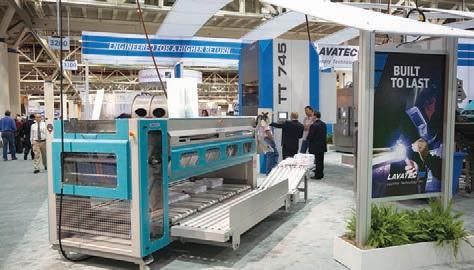

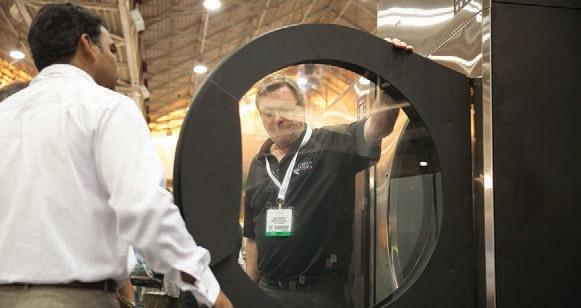
Many exhibitors reported that attendees they spoke to had come to New Orleans with a show strategy and were seeking to achieve specific goals, including gathering information about new or nextgeneration products or even making arrangements for purchases of laundry and dry cleaning equipment, textiles, and other items.
Clean offered some 40 hours of educational programming to attendees. For the first time, it hosted afternoon educational sessions right on the show floor, and some of them drew standingroom-only crowds.
Other additions at this year’s exhibition were a mobile device app that attendees could use to more effectively plan their show visit, and a more active social media presence in support of the show. Monitors strategically placed throughout the massive
exhibit hall displayed tweets featuring the hashtag #Clean2013.
The next edition of Clean will convene in Atlanta in April 2015, confirms Brian Wallace, Clean ’15 chairman and Coin Laundry Association CEO, but the show’s length is undetermined.
At press time, the Clean Executive Committee was waiting to gather feedback from exhibitors and attendees regarding this year’s three-day show “experiment” to decide if the 2015 show will remain three days in length or shift back to the traditional four days, Cotter says.
Show sponsors are the Association for Linen Management (ALM), CLA, the Drycleaning and Laundry Institute (DLI), TCATA and the Textile Rental Services Association of America (TRSA).
Four of the five sponsors organized educational sessions, as did the American Reusable Textile Association (ARTA), the Canadian Cleaners and Launderers Allied Trades Association (CLATA) and the European Textile Service Association (ETSA).
Following the 2015 event in Atlanta, the Clean Show will return in June 2017 in Las Vegas, and the Clean Executive Committee has signed a letter of intent to bring the show back to New Orleans in June 2019.
Watch for the more comprehensive Clean Show Report, Part II, coming in the August issue of American Laundry News! ALN
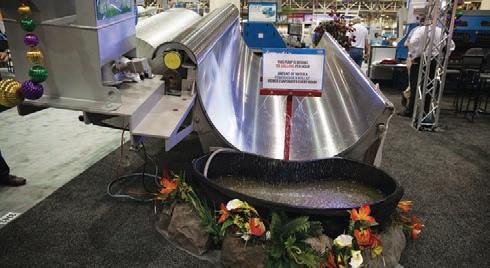

6 JULY 2013 | AmericAn LAUndrY news www.AmericanLaundryNews.com
continued
from Page 1 clean
Rick Murphy (right), American Dryer Corp., is right in the center of things as he demonstrates a piece of equipment. (Photo: Nathan Frerichs)
Members of the Kannegiesser staff line up in preparation to greet attendees on the show’s first day. (Photo: Bruce Beggs)
Kim Shady (center), Laundrylux, gets help putting on a microphone prior to making a presentation about his company’s new PLUS program. (Photo: Bruce Beggs)
Chicago Dryer Co. used a fountain to demonstrate how much water one of its ironers evaporates hourly. (Photo: Nathan Frerichs)
Lavatec Laundry Technology unveiled some new products in New Orleans, and announced that President Mark Thrasher had increased his ownership stake in its German-based parent company (see page 9). (Photo: Nathan Frerichs)
G.A. Braun had one of the largest booths at the show. (Photo: Nathan Frerichs)
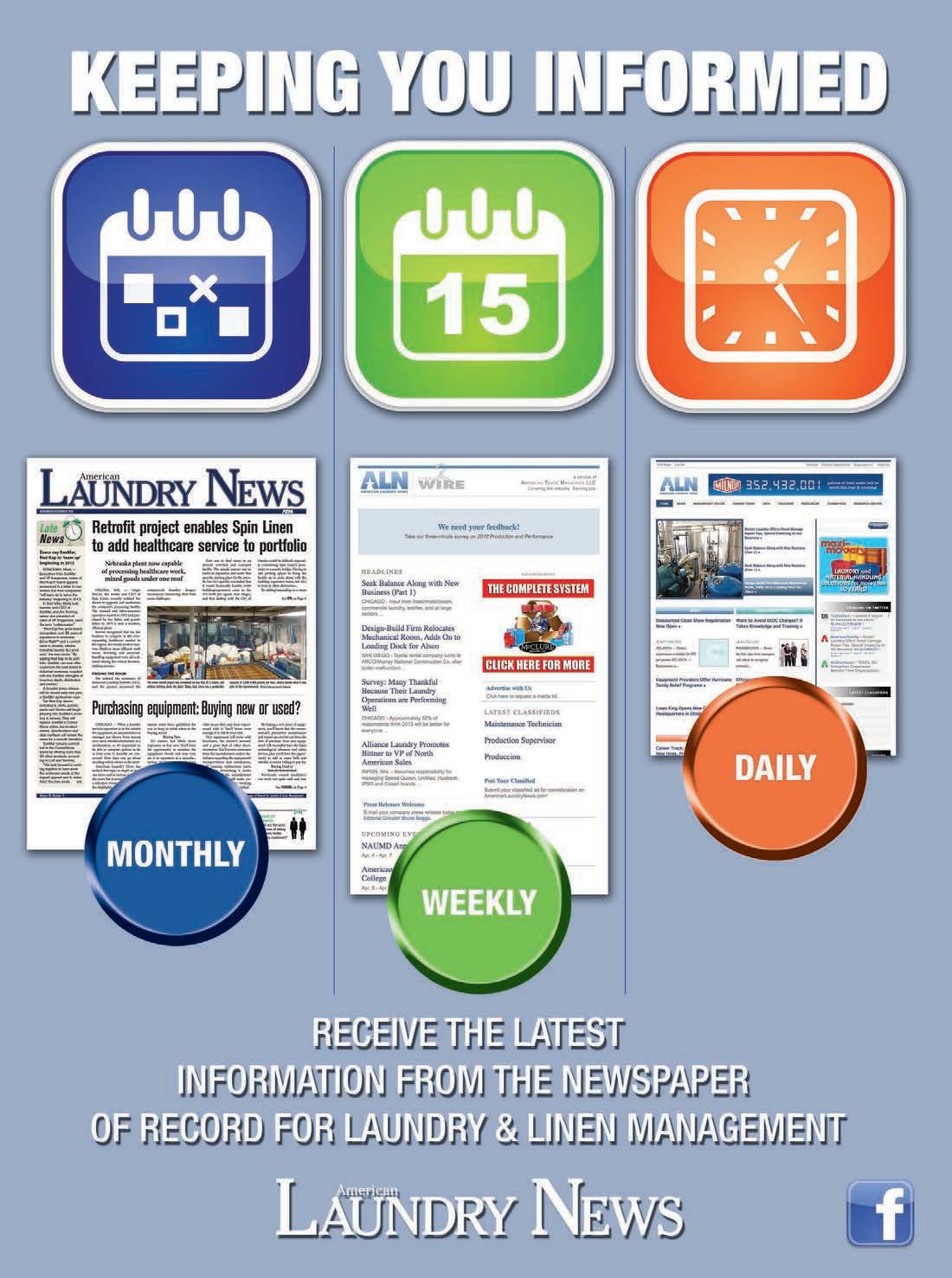
Global market changes heighten textile sourcing, selection challenges
BY JeAn TeLLer, conTriBUTinG ediTor
CHICAGO — Global market changes continue to make textile sourcing and selection a challenge for today’s textile services manager, according to Dr. Elizabeth Easter.
During a seminar for TRSA’s most recent Annual Conference, Easter spoke on the Impact of the Global Marketplace on Textile Quality
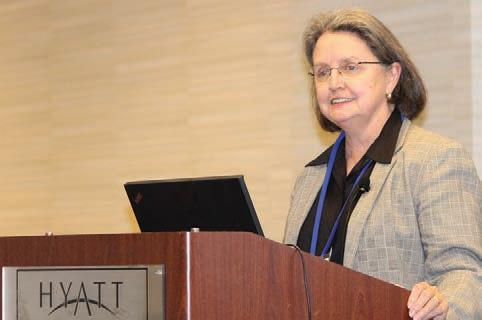
The University of Kentucky professor, and founder of the Textile Testing Laboratory on the UK campus, started with a short history of the textile and garment industries, which shows similar parallels to today’s global marketplace, she says.
“We basically see that both industries contributed to industrialization and also now contribute to the global marketplace,” she says. “Textile was an industry that could be used to help rebuild Japan (after World War II).”
The United States has taken similar steps to help develop Korea, Taiwan and Hong Kong, all countries that are now competitive with the United States in the textile and garment industries.
It wasn’t until the 1970s that the U.S. industry recognized the entry into the global market and the competition of some of the other developing countries. Easter says the industry now acknowledges that Nike and Reebok were the first brands to take their business offshore or overseas. Neither company owns factories; they simply contract with factories mainly in Asia to product their brand products.
THE MULTI FIBRE ARRANGEMENT
Easter points out the effects of the Multi Fibre Arrangement (MFA) established in 1974 as a way to impose quotas on exports from developing countries. It was a way for developed countries to compete with the
lower labor and other costs that developing countries were able to work under.
There were limits to the MFA, however, and by 2004, it had been phased out.
Without its constraints, the global marketplace for textiles and apparel exploded. Today, says Easter, the industry has evolved into a wide open marketplace.
She says, in 2011, the United States exported $22.3 billion in apparel while importing $102 billion in textile and apparel products.
INDUSTRY CHANGES
The largest change in the industry, according to Easter, is that it is now a buyer’s market, rather than a supplier’s market.
In years past, the supplier would be the one to dictate product, price, delivery times and lead times.
While the industry is still labor-intensive, a buyer now carries more weight as to what is produced. Walmart, Easter says, has played a huge role in the new industry. The corporation can mandate a price, a quality that is close to traditional brands, and can control lead time and raw materials. As a result, we have seen a move to lower prices, better quality, faster delivery times and smaller minimum quantities.
The consumer has also changed, Easter says. From 12-14% down to 8%, the U.S. consumer now spends less on apparel items but demands more quality. The average consumer has more garments and home furnishings than in the past, all made of textiles, and they also shop more frequently and buy more items.
SUSTAINABILITY
One major change in the textile and garment industries is sustainability, and consumers are looking to be more sustainable while using less and saving more, Easter says.
In addition to sustainability, concern is
growing that the industry has moved back to the original issues that it once faced: poor working conditions, lower hourly wages, and long work hours. Product marketing frequently promotes that the companies inspect and guarantee the social conditions in which the product was produced in the global market.
Concerns about the environmental degradation of the global marketplace are also on the rise, Easter says. While U.S. industry is highly regulated, that is not the case in the rest of the world. The industry needs to be aware that precautions taken in the United States need to be applied to the global market, Easter says.
Something else that the industry needs to realize, she says, is that it is a completely different industry than it once was. With changes in the economic landscape, many companies no longer exist, with takeovers and consolidations changing the industry all the time. She pointed to DuPont, which was once a major player in the development of synthetic fibers. The company is no longer working in that part of the industry, relinquishing its role to more foreign-based companies.
Technology has also changed the industry. With the innovations of bar codes, point-of-sale scanners and other computer technology, the industry now has the ability to gain immediate feedback on items that need to be restocked as well as a change in communication ability.
MOVEMENT TO RESHORE
Some of these changes, Easter says, has allowed companies to begin to
reshore, or bring back manufacturing and other parts of their businesses to the United States or to closer locations. With the new communication systems in place, firms no longer have to go through a supplier, they can directly contact the manufacturer to place an order.
The “Made in America” movement continues to be strong, Easter says. She pointed to an ABC News report that demonstrated that most people going through Grand Central Station rarely wore anything that was made in the United States—every piece of clothing was created in another country.
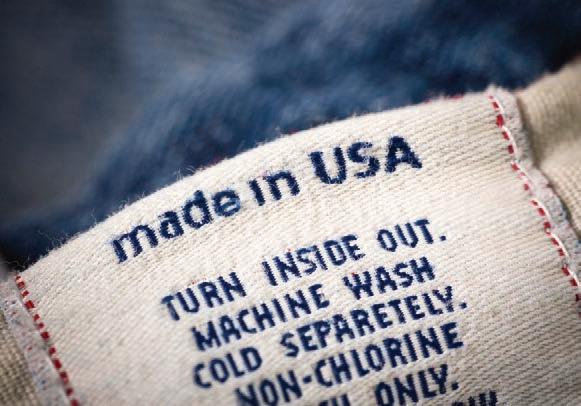
“There is a tremendous amount of work to reshore, if we choose to do so,” Easter says, “and we have to do so one small step at a time.”
INDUSTRY EVOLUTION
Easter says textile services managers can now be seen more as production managers in the textile industry, which needs to move more toward technical packages to help with communication between groups of people who may not speak the same language or have the same customs and culture.
This has replaced the concept of design or production that we have had in the past, she says, thus we need to move more toward specification buying and consumption.
These packages would contain specs on fiber content, buttons and size, where a label is placed and what it is made of, whether the product will be displayed on a hanger or if it will be folded and packaged; the specification package will contain everything a plant needs to produce a particular item.
But this does not relieve the buyer of its responsibility in the process. Easter says buyers must be more diligent in testing the finished products, looking for illegal substances, heavy metals and other banned or unsafe materials.
“We can no longer receive a product and assume it meets our specifications,” she says. “We may have a global market, but it is our responsibility to confirm we have the quality of product we want.” ALN
8 JULY 2013 | AmericAn LAUndrY news www.AmericanLaundryNews.com
Dr. Elizabeth Easter addresses the TRSA Annual Conference. (Photo: Bruce Beggs)
(Photo: © iStockphoto/ Pgiam)
Thrasher boosts ownership stake in parent company
BEACON FALLS, Ct. — Mark Thrasher, president of Lavatec Laundry Technology Inc. (LLT), has “significantly expanded” his ownership of German-based parent company Lavatec Laundry Technology GmbH to 49%, according to LLT.

The move strengthens his partnership with CEO and Managing Partner Wolf-Peter Graeser, broadens his involvement as comanager in global operations, and reflects both parties’ confidence and commitment to asserting LLT leadership in the industrial and commercial laundry marketplace, the company adds.

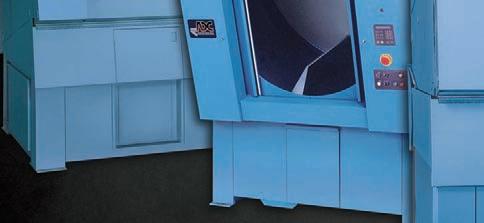

Since becoming president of U.S. and North American operations in July 2010, Thrasher has driven stepped-up product development and line expansion efforts, LLT says. He helped reinvigorate the LLT distributor network and fortify the company’s customer service and aftermarket capabilities, and led an initiative to more closely connect LLT with user issues, the company says.
Track Career
Braun promotes Gudenburr to company president

SYRACUSE, N.Y. — G.A. Braun has promoted Chief Operating Officer Joe Gudenburr to company president, Braun CEO and Chairman of the Board JB Werner has announced.
Gudenburr joined Braun in 2003 as vice president of opera-



tions, with responsibility for all engineering, service and operations initiatives. His role expanded in 2006 with promotion to COO, adding responsibility for domestic sales and marketing efforts.
is a United States
Military Academy graduate with an extensive domestic and international operations, sales, and research and development background.
“Joe’s hard work, dedication and loyalty to our business and

industry is exceptional,” Werner says. “I am proud to have Joe as president and look forward to working with him to continue our strategic domestic and international growth initiatives.”
As owner, CEO and board chairman, Werner will now look to expand his focus on strategic business investments, and on company initiatives in Braun’s core business and complementary business ventures.
The Future is
MCDONOUGH, Ga. — Encompass Group LLC has named John J. Wood its chief executive officer, replacing the retiring Mike Spurlock, who will continue as a member of Encompass’ Board of Directors.

Wood has more than 20 years of experience in increasingly responsible positions within the healthcare industry, Encompass says, with companies such as Standard Healthcare, Baxter Healthcare, Allegiance and Cardinal Health.
He became executive vice president of sales for the Encompass Textile and Interiors Division in 2002, and was promoted to senior executive vice president and general manager of the Acute Care business in 2007. In late 2012, he was appointed to the Encompass board in a non-voting, advisory role.
Wood holds a bachelor of science degree in marketing from Appalachian State University in Boone, N.C.
Encompass Group names Wood CEO; Spurlock retires
Gudenburr
ALN
Wood
Thrasher
www.AmericanLaundryNews.com AmericAn LAundry news | Ju Ly 2013 9
Gudenburr
BIGGER In the commercial laundry world, bigger is better! ADC’s family of industrial dryers are a smart investment with BIGGER benefits. The AD-200, AD-310 and AD-400 have everything you need to plan and achieve BIGGER profits and a return on your investment. Save time and money on labor, maintenance and utilities with ADC’s advanced technology and engineer-driven designs. Bigger Benefits include: Choice of gas or ADC’s steam damper system, standard stainless steel baskets, computer preprogramed cycles for one-touch drying, and much more. Start planning for a BIGGER future. Call your ADC local distributor for the perfect package deal. Get More for Your Money with ADC. ALN_Jr Page.indd 1 6/11/13 8:45 AM
PAnel of exPeRTs
Making the case for capital improvements

ment. Sheet separators can eliminate labor; cornerless spreaderfeeders with self-contained thermal ironers can produce more pieces per hour with fewer operators than steam-heated ironers with traditional clip-type feeders.
ered as a result of operational cost savings. It is calculated by dividing the cost of the investment by its annual resultant savings. In these instances, ROI is a simple payback analysis.
information to them.
Being an effective and persuasive communicator, both to upper management as well as to employees, is the hallmark of a successful operator.
ROI—return on investment— has always been a necessity in getting capital improvements approved, but it has never more critical than in today’s economic climate. The sooner you can realize that return on your investment, the more likely you will get your capital request approved.
The first thing a laundry manager or textile rental operator needs to do is assess operations. What do we need? How will it improve our operation? Will it add value to the process? How will we pay for it? Once the questions are answered, then an economic analysis needs to be prepared to find the ROI.
We usually start with the utility bills and labor cost. For example, if you have a washer-extractor plant, then you will have higher utilities and labor costs than a batch-washer plant. If you process 1,200 pounds or more per hour, then a CBW® system will certainly give you a quicker ROI than a washer-extractor plant. Look at your required pounds per hour to determine if a CBW® is a better fit for your operation.
In today’s market, we have continuous batch washers capable of processing light soil using 0.3-0.4 gallons of water per pound vs. 2.7 gallons per pound in a traditional washer-extractor plant. That is an amazing 2.3 gallons per pound savings on light soil.
If you process 20,000 pounds per day, 365 days per year, that adds up to almost 17 million gallons of water saved. Let’s assume the water cost is around $6.50 per 1,000 gallons, so the water savings alone would be more than $100,000 per year. Based on this example, labor, gas, electric and chemical savings could add up to another $400,000 per year or more. It isn’t uncommon in today’s market to get a two- to three-year return on a CBW® system.
The same analysis can be used for all types of laundry equip-
It all adds up in the end. The more pounds per operator hour (PPOH) you can process, the lower your cost will be. This equals profits, which leads to capital being available for your plant.
For example, the purchase of three flatwork feeders at a total cost of $225,000 results in labor and benefit savings of $75,000 annually. In this scenario, the cost of the equipment is recovered in three years ($225,000/$75,000 per year = three years). Generally speaking, an ROI of three years or less represents a sound investment of capital.
Judy
North
increase output, but may provide automated options to manual labor, thereby decreasing labor costs. This information should be made available to the decision makers, but must be based on accurate, sustained and proven data collection.
The squeaky wheel doesn’t always get the grease. When trying to make the case for capital investment in any laundry facility, administrators and investors alike want to see cold, hard facts. Laundry managers and operators will need to show data demonstrating the return on investment (ROI) and internal rate of return (IRR) that the capital asset will generate.
Whether a laundry is operated as a for-profit entity or as a cost center such as a co-op or OPL, the senior management is charged with employing a specific level of assets that will deliver an expected financial result in a competitive market. In other words, each organization has a finite amount of capital to allocate.
The successful laundry manager needs to become familiar with financial calculations such as ROI and IRR in order to effectively communicate with upper management and obtain necessary capital.
The ability to acquire capital to upgrade, renovate or expand is a key component in operating an efficient, sustainable laundry.
ROI is a performance measure used to evaluate the efficiency of a capital investment or to compare the efficiency of a number of different capital investments.
In the laundry industry, investors and administrators typically measure the number of years, or fraction thereof, that an investment of capital would be recov-

In another example, the addition of a blanket folding system at a cost of $125,000 results in annual labor and benefit savings of $55,000. The ROI in this case is two years, three months. This makes the blanket folder, in the mind of an investor, a more sound capital investment than the flatwork feeders.
As a rule, the higher the labor cost, the quicker the payback on automated equipment. Operations with low labor costs will find it more difficult to justify capital expense for equipment acquisition, as payback will usually exceed three years.
The IRR takes into account the time value of money. It examines the net present value of all cash flow required for the initial asset purchase, and the prospective increase in cash flow as the result of reducing operating costs. Most financial managers will use a fiveyear IRR as the chief criterion when allocating capital.
The rule of thumb is simply this: the higher the IRR, the more viable the investment of capital. Typically, the minimum acceptable IRR is 12%. An ironing system with an IRR of 10% is a far less attractive capital investment to an investor than a small-piece folder with a 50% IRR.
The IRR should not, however, be used to rate mutually exclusive projects, such as an ironing system vs. a small-piece folder, but only to decide if the equipment is worth the capital investment in the first place.
Since senior management and investors rely on cold, hard facts, it is incumbent for the laundry manager to effectively communicate laundry operating statistics and other relevant
Healthcare providers are facing some of the most critical challenges in recent history. Decreases in reimbursements; dwindling investments; healthcare reform; costs associated with the implementation of an electronic medical record; and increasing costs to provide care are just a few to consider.
With all this uncertainty, the ability for service departments and/or industries to tap into any capital funding seems to be an impossible task. Yet, it is clear that with the aging of one of the largest sections of our population, the Baby Boomers, healthcare will continue to be needed in the long haul. As a result, processing the linens and supplies needed to provide care will also continue.
In order to provide these quality linens, it is imperative that the laundry manager keeps accurate records of his/her equipment needs. The ability to figure needed production capacity is a must in order to determine the appropriate type, size and features of the equipment, and to figure the appropriate amount of labor needed to operate. In addition, equipment utility requirements must be available so that additional utility capacity is planned prior to requesting capital funding.
To be able to justify the need for replacement/new equipment, a good manager should provide accurate downtime data, equipment efficiency/utilization reports, productivity information, etc., for review. Older, slower, worn-out equipment that requires constant maintenance/repair can affect the productivity of a facility. Newer equipment with increased operating capacity may not only
In most cases, older equipment does not efficiently utilize resources and/or utilities. The push to become “green” is strong, and the need for newer, energy-efficient equipment and facilities is necessary for this industry to sustain itself. The good manager remains abreast of any changes in regulations, utility savings opportunities/programs, waste management efforts, recycling opportunities, etc. He/she must implement “best practice” in order to be costeffective and remain competitive.
The good manager should glean information from associations that have benchmarking, best practice and industry standards that can help guide his/ her operations. By developing resources, staying in touch with colleagues and experts in the industry, and developing successful strategic plans and market forecasting tools, the manager can apply much needed information not necessarily found in instruction books.
Finally, the manager should look for other capital funding programs that can be utilized to help subsidize the healthcare entity or financiers. Government programs and regional, state and local programs may be available and can be accessed if the facility qualifies. Joint ventures, bonds, small business loans, etc., may also provide needed capital for improvements.
To appropriately justify capital improvements, an OPL manager must demonstrate that any changes will accomplish at least one of two things: increased productivity or decreased costs.
For example, a customer evalu-



10 jUly 2013 | AmeRicAn lAUndRy news www.AmericanLaundryNews.com
How can an on-premise laundry manager most effectively demonstrate to administration (or a for-profit textile rental operator demonstrate to financiers) the need for capital improvements in his or her plant?
equipment manufacturing Steve Hietpas
Maytag® Commercial Laundry St. Joseph, Mich.
equipment/ supply distribution
Bill Bell
Steiner-Atlantic Corp. Miami, Fla.
Healthcare laundry
Murphy, RN, BSN, CLLM, RLLD
Mississippi Medical Center (NMMC)
Tupelo, Miss. Hotel/motel/ Resort laundry Charles Loelius
The Pierre New York New York, N.Y.
ates switching to a more expensive chemical company. And, although the chemicals cost more, the customer is able to cut its water usage and hot-water consumption on non-healthcare items as a result of the upgrade. The reduction in water usage and hot-water costs outweigh the increase in chemical price, and the OPL facility manager opts to switch chemical providers.
The payback period for any capital improvement should also be considered when making upgrades. Somewhere in the neighborhood of three to five years is a reasonable payback time.
In terms of financing, if a company can’t afford the capital improvements outright, management will need to borrow from the bank, like many businesses do. And, although it is easier to borrow from the bank now than it was two years ago, companies must provide extensive financial information. Financiers will want to understand:
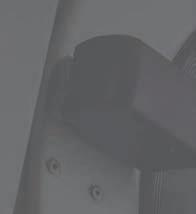
• Is there existing cash flow to help pay for the improvement?

• If there isn’t existing cash flow, how does the facility plan to take on the additional capital-improvement costs?
• Are there any increased commitments from current or new customers as a result of the capital upgrades?
Properly understanding the expected benefits, the payback period and requirements to receive financial support are required to effectively demonstrate the need for capital improvements.
ity, then hold these numbers up to light in comparison to what would be anticipated if key improvements in machinery, plant layout and basic infrastructure are implemented.
In most cases, there is a lot to be gained, even if only incremental steps and spending are approved toward improving production levels and lowering production cost.
You know your laundry. You know its strengths and weaknesses. Begin to identify the obvious bottlenecks in production; the places where full carts sit and accumulate will point you
in their direction.
So often, we hear owners and managers say if only they had more, or better-running, or bigger washers, dryers or finishing equipment, they’d be out on time each day, or be able to add valuable new business that’s available for the taking.
So how do you build your case for the powers that be? A good place to start your quest is by breaking down production poundage into classifications on a weekly basis. If your business has seasonal trends, you will know your peak-level poundage on busy weeks and then average
the poundage for an entire year. Having these numbers will help you in several ways.
If you see major poundage in like classifications, and you have a row of smallish pony washers, then you can be sure that investing in a larger-capacity washer or two would save considerable water, chemistry, labor and production time.
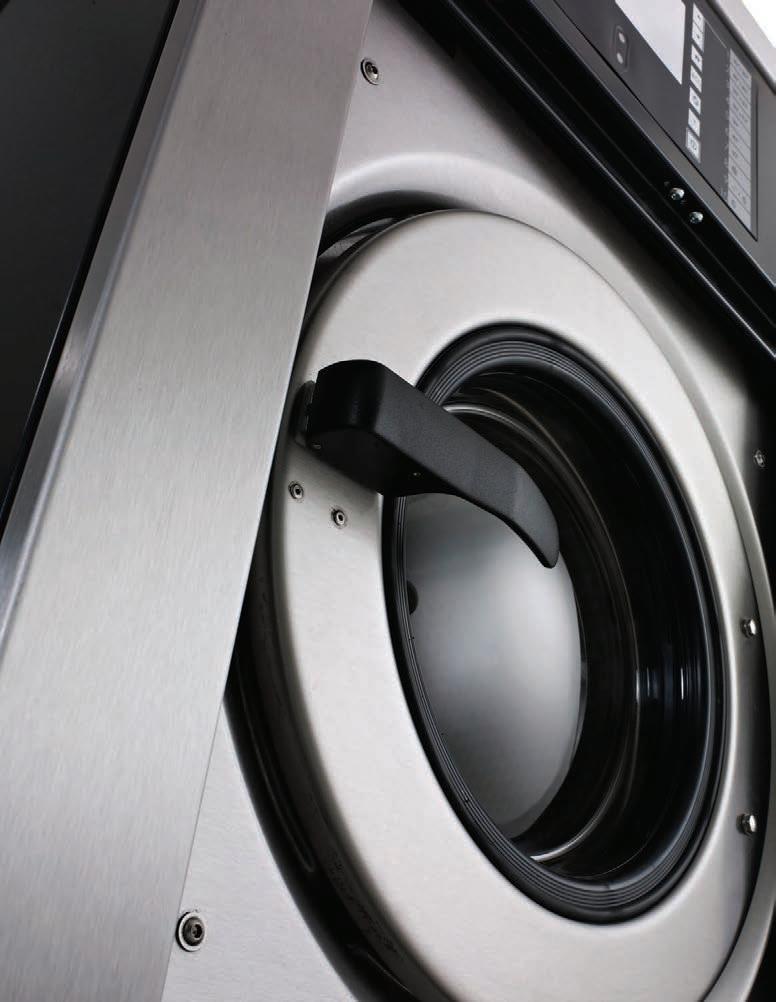
Your trusted equipment supplier and chemical supplier should be able to provide you with actual data on “gallons per pound” of water usage and “chemical costs per hundredweight” for various washer sizes and key wash formu-
las. The significant savings and efficiencies of larger washers grow even more when medium and heavy soils are considered.
Equipment selection is symmetrical, so if washers are a concern, then the capacity to make hot water has to be determined and matched to any washer-size upgrades. We all know that hot water, even with the newer highperformance chemicals now available, is still a constant, important tool in producing clean laundry. If your hot-water system is oilfired, then it’s time to investigate
It is time to invest in capital improvements in your laundry. You know it, your staff knows it, but how do you get this idea across to the principle deciders who sign off on financing or write the actual checks?
Important decisions must be supported with actual due diligence to help point out and determine the potential benefits and upside profitability of investing this capital.
There are the obvious resistance points. It is human nature to resist change. It takes less effort to stay the course and muddle through every production day with what we have in place, even if the days are longer, more water and energy is consumed, and quality and sometimes even safety take a back seat.
Your task is to gather the all-important information and production data from your facil-

www.AmericanLaundryNews.com AmerIcAn LAundry news | j uLy 2013 11 american laundry news jr page 7.75x10 For laundry done on time and on budget, there’s no better choice than IPSO ®. Forty years of European ingenuity, rugged industrial construction, and our intuitive Cygnus controls all add up to help you achieve your ultimate goal — maximum throughput at a minimized cost. Learn more about how IPSO helps you get the job done at IPSO.com/industrial INDUSTRIAL BY DESIGN Work with your IPSO finance expert to learn about customized financial solutions for your business. IPSO USA 1.800.USA.IPSO IPSO.com/industrial INDUSTRIAL BY DESIGN. Optimal Efficiency. Maximized Throughput. 3929_IPSO OPL_jrPg amerlaundnews v2.indd 1 2/6/13 4:29 PM ALN_Jr Page.indd 1 See EXPERTS on Page 12 chemicals supply Philip L. Bodner Metro-Chem Kearny, N.J.
what natural gas would save. In many cases, the immediate savings from converting are large enough to underwrite the cost of financing a new, much more efficient hot-water system that will serve your future needs.
If a properly sized and efficient hot-water system is installed and you have live steam-heating loads where the old system couldn’t keep up, you will receive additional energy savings from less dependence on that live steam. Excessive injection of live steam into the washer is the most expensive way to heat water. An additional benefit is the ability to schedule off-hour laundering when the plant’s main steam boiler is off.
Dryers are often undersized and overlooked when considering plant improvements, and are frequently the cause of bottlenecks in laundry operations. Light-soil plants, for example, sometimes launder terry towel loads at faster rates than the dryers can dry them. Temperatures are then raised in an attempt to keep pace, resulting in crisp towels that no amount of fabric softener can remedy. Less drying capacity also increases chances of overloading, which will result in plenty of extra wrinkling that compromises finishing quality. The right size and quantity of efficient dryers ensures that the work keeps moving.
Ironers and folders probably deserve an entire chapter in the scheme of improved production efficiency. Older and, in many cases, under-serviced ironers and folding equipment can really put a hitch in your giddyup when you are trying to get done what’s needed in an 8-hour day.
Replacing ironers and specifically all “shop-worn” folders can make an immediate impact on quality, reduce bad work that must be redone, and reduce calls to engineers to untangle goods that are stuck or to get the folder to fold properly (till the next time it doesn’t).
Though we like to see people employed, we can’t run an efficient, profitable laundry when we are forced to employ too many sets of hands. Newly designed ironer-feeding and folding equipment helps ensure that extra hands are not needed, offering a huge labor savings. The resulting finished package will look better, too!
I would be remiss if I did not mention the benefits of upgrading lighting to see what you’re doing, of having enough carts, and of having carts with wheels that still turn easily. Having some trained eyes help you take a good look at your workflow pattern can reveal better ways to route soiled work to finished work with relatively
little investment.
To justify any real investments being made, you must do the work to present the expected results and inherent efficiencies the proposed investments will yield. It will always come down to what it would cost vs. what it could save. If investment can mean the difference between starting a second shift or not, then your job should be easy.

You can do all the research in-house, but I suggest getting your associated vendors involved to assist in their specific fields of expertise. You may want to ask if they can arrange to take you and your decision makers on a field trip to other laundry operations that have accomplished progressive results from recent investment in equipment or infrastructure. I have found this “Let’s go see it ourselves” idea to be a good way to go.
So, go forth and venture, profit, and enjoy the gains.
more with less but not increase our overhead?”
With the laundry manager, his task is seemingly simple, so we think.
• How do we increase our pounds per operator hour (PPOH) within our production facilities without adding to our bottom line?
• What are the hidden known drivers we need to be concerned with while trying to meet this new demand of increased production?
• What can we do differently to reduce our labor, energy costs, water consumption, gas consumption and electricity consumption?
• What can be done to increase production within our plants without adding staff?
• How can we maximize our space to enhance our production flow and quality of product we are sending out to our customers?
we consider building a bigger, more efficient facility?
New equipment these days is state of the art and can drastically reduce water consumption, electricity costs, natural gas costs, processing costs and even staffing needs. Simply put, it allows you to produce more with less, and may be the answer to all of the earlier questions. By providing this “answer” to administration (or the financier), you will demonstrate the need for an investment in capital equipment.
It is also important to consider, as you strive to be an environmentally friendly business, what new technology can you offer in terms of recycling water and reducing energy costs. This is also something that needs to be calculated into the return on investment (ROI) calculation.
resources, safety, fleet management, water reclamation…the list goes on.
To run a successful plant, laundry managers need to be aware of industry changes and react so as to secure and protect their plant’s future. And, although the concept of running a laundry appears basic, the costs of today’s capital improvements can give a whole new definition to the term “sticker shock.”
Capital improvements can easily be presented and requested when you have the good fortune of additional sales and growth, but what about expanding, improving processes or replacing equipment during times of normal operation?
Developing an overall capital improvement plan can be vital to maintaining a constant profitable and healthy bottom line.
A
s laundries get larger and processing costs continue to rise, many laundry managers are facing pressure to increase production while at the same time reducing their costs. While walking this tightrope, they also want to make sure that the quality of product being produced in their facilities is not jeopardized.
Laundry managers and textile services company owners face the same dilemma as other industry leaders: “How can we produce


For some of these questions, the answer may be found within a simple tweak, such as re-evaluating current plant layout and redesigning production lines to increase the flow. In other cases, it might be re-evaluating staff and moving workers around to maximize their efficiencies and production skills. Ultimately, however, it comes down to evaluating what needs to be done and determining if it can be accomplished with the existing building, plant layout, equipment and staff.
Do we have the correct amount of space in our existing facility to meet our new demands or must we look for that elusive buildingstretcher to maximize our space to accommodate our new capacity needs?
Using our existing floor plan, do we need to go up or out to fit new equipment into our facility or must
Along with capital investments in new equipment, it is important to also examine fabric technology and ensure you have the proper match between it and your processing equipment. When reviewing capital needs, it is important to re-evaluate the merchandise being processed in our plants as well as consider changing fabric technology, because new fabric technology has helped to boost energy savings and product life.
By creating and maintaining a list of presently needed and future capital improvements, the laundry manager can plant the seeds for growth. Providing this list of improvements with those who finance the needed funds allows a period of time for discussion and consideration for phases of improvements.
Each capital improvement should include total installed cost along with any benefit of a payback, such as lower utility usage, shorter production time, customer benefit, safety improvements and (lack of) repairs. It’s always best if you can prove out the benefits and features through the improvement’s specifications rather than personal opinion.
communication, technology, human
Finally, by providing a lineitem budget projection, the laundry manager can demonstrate that they have performed their due diligence and can show the overall financial impact of the requested capital improvement.
Consider the improvements and changes that textile rental plants have made within the last 20 years with respect to
ALN 12 jUly 2013 | AmeriCAn lAUndry news www.AmericanLaundryNews.com
Continued from Page 11
experts
Uniforms/ workwear manufacturing Scott Delin Superior Uniform Group Seminole, Fla. Textile/Uniform rental Tom Peplinski Golden West Oakland, Calif.
(Photo: ©Ingram Publishing/Ivelin Radkov)
Tunnels ease workflow, boost efficiency for Detroit co-op
DETROIT — Processing nearly 10 million pounds of laundry a year for nine hospitals means about 81/2 hours of nonstop operation for Metropolitan Detroit Area Hospital Services Inc. (MDAHS) every weekday starting at 7 a.m.

A co-op service for five acute care facilities with more than 1,400 beds and four clinical/surgery centers, MDAHS began servicing member institutions in 1972.
A recent 11,000-square-foot addition gives MDAHS a total of 47,000 square feet for equipment used to handle the network needs of Trinity Health System and Henry Ford Health System facilities as far west as Chelsea, with the largest single facility being St. Joseph Mercy Hospital in Ann Arbor.
“Our members rely on us for timely processing and delivery of goods that adhere to stringent healthcare standards,” says General Manager Jillane Mannlein. Those tasks have become a lot easier—and the quality of processed goods much better—since two 14-compartment Lavatec Laundry Technology batch tunnel washers were brought on-board, she adds.
“Although our previous machines were state-of-the-art when first installed, several production issues persuaded the Co-op Board to agree to replace them,” Mannlein says.
Assistant General Manager Dave Haas, a 30-year laundry industry veteran then in his third year with MDAHS, played a key role in the search process.
SIMPLICITY, RELIABILITY
“It’s a simple machine compared to others, well-engineered and well-built,” Haas says. “We’re a no-frills laundry and we don’t spend money on extraneous stuff. We invest in equipment and keeping costs down for our members.”
Haas points to Lavatec tunnels’ minimal moving parts where less can go wrong.
The bottom-transfer tunnels are easy to operate, and the controls are simple and user-friendly, he adds.
Why 14 compartments at 110 pounds each? “This was worked out with Lavatec, to deliver the productivity we need while giving us adequate rinses,” says Haas. “It also provides potential for running more pounds per hour through the machines.”
Haas says the automated systems keep goods flowing smoothly. “These tunnels are very reliable. They just work.”
NOTICEABLY BRIGHTER
What’s more, their “work” delivers the quality output that MDAHS member hospitals look for. “There was a huge improvement in whiteness in all of our goods when we started using the
Lavatec tunnels,” Haas reports. In addition, “the batch process avoids even incidental mixing of, say, scrubs and sheets, which sometimes occurred with our previous machines.”
Water usage dropped by about 25%, according to Haas. Less steam is required, too, due in large part to switching to gas dryers. “We used to run two of the three boilers with the old dryers,”
BraunALNRecapAd_Layout
he says. “Now, we only use one. Granted, there is some trade-off in savings, with gas for the newer dryers.”
The combination of Lavatec extraction presses and a centrifuge also effectively minimize drying times and, in turn, energy required.
KEEP THINGS MOVING
MDAHS employs two Lavatec
1 5/31/13 9:17 AM
hydraulic extraction presses, a centrifuge and two shuttle conveyors servicing a dozen 220-pound dryers, plus uses two Lavatec washer extractors with stand-alone dryers. Conveyors link system components and move goods from dryers into finishing, and a Lavatec rail system gets the laundering process literally up and running in soil sort, expediting overhead transfer of loads to each washer.
MDAHS launders surgical garments and mattress underpads that contain water-resistant micro-denier fabric. Those batches go into the centrifuge for spin extraction, so as to preserve linen integrity while prepping the goods for fast, efficient drying.
“The Lavatec tunnel system has turned out to be one of the best investments we’ve made,” Mannlein says. ALN
Now that another successful Clean Show has ended, we just want to say THANK YOU to those who visited our booth!
www.AmericanLaundryNews.com AmericAn LAundry news | Ju Ly 2013 13
It's easy to get swept up in all the excitement of the Clean Show...
Page
We enjoyed spending time with you and helping to acquaint you with our products and services. For more information on all of the new products we demonstrated, please contact us at 800.432-7286 ext. 217 I gabraun.com ALN_Jr Page.indd 1 6/3/13 4:48 PM
1
RAMCO LAUNDRY MACHINERY
RAMCO’s DS/DE 60 Industrial Dryer, designed for small commercial loads up to 60 pounds, is the smallest model in the company’s broad line of dryers.
A user-friendly model, the DS/ DE 60 features microprocessor controls, is fully automatic, and is ideal for drying a variety of fabrics, RAMCO says. It also offers the convenience of automatic control and timer drying, as well as an automatic-reversal drum.
Its large window allows the user to check on drying conditions, and the lint drawer is easily accessible.
The dimensions of this unit are 50 inches by 41 inches by 70 inches. Safety switches throughout the dryer also provide protection for the operator.
ramcolaundry.com 800-878-5578
pause, then switch direction. This helps reduce balling or roping of large articles, such as sheets, comforters and tablecloths, which causes the center of the linen to be less dry than the outside, the company says. The reversing feature provides a consistent, even dry of the laundry.
Productivity will increase because employees no longer need to spend extra time untangling linen, the company says, and also will help laundry managers increase throughput and reduce energy costs without compromising premium linens.

ELECTROLUX
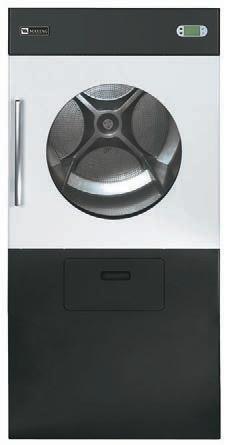
Designed for maximum airflow and generated heat, Electrolux dryers are 12% faster and use 25% less gas than leading competitors, according to the company. Electrolux products are distributed in North America by Laundrylux.
Features of Electrolux dryers include autostop, which prevents over-drying and wrinkling by automatically calculating the correct time to turn on and off the burner, resulting in longer linen life and energy savings; and a reversing drum to minimize tangling and wrinkling, thus improving dryer efficiency. This feature is free on every dryer, Laundrylux adds.
Each Electrolux dryer features a lint tray with a hinged door to allow for fast, convenient lint removal, as well as

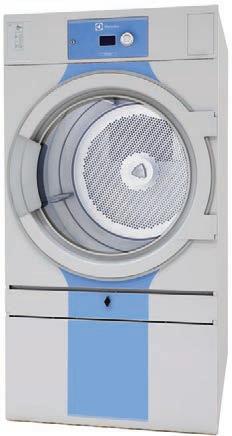
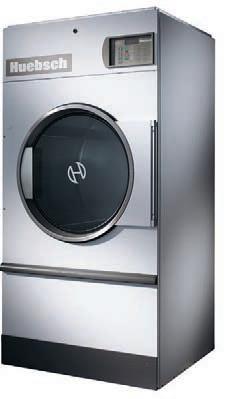
residual moisture control, which helps give the operator a precise control of the remaining moisture in a load. The feature helps with processing linens that require a small amount of dampness to press. It also helps to prevent over-drying and reduces lint and wrinkles.
laundrylux.com 800-381-7222
CONTINENTAL GIRBAU
programmable cycle types—time-dry, auto-dry or the company’s Linen Life Extension (LLE) moisturesensing system—the ProSeries II dryers offer drying technology and load management control.
The LLE moisture-sensing system features 12 programmable dryness levels and can target any dryness level from zero to 40%, the company says. When the load has reached its preset target level of dryness, the control shuts the dryer off, which saves energy, time and labor costs. Goods also experience less damage and up to 31% less fiber loss, Continental says. LLE helps to reduce overdrying and fabric damage, with cuts in energy and labor costs.
Pro-Series II single-pocket commercial dryers also offer optional Integrated Sprinkler Systems (ISS) that sense and extinguish dryer fires.
continentalgirbau.com 800-256-1073
HUEBSCH
Huebsch offers on-premise laundries a 50-pound tumble dryer with reversing technology.
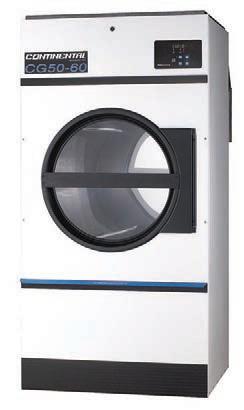
The reversing technology allows the machine to stop,
The feature is available with the Galaxy™ 600 control for tumble dryers, the complementary control to the Galaxy 600 washer-extractor control.
huebsch.com 800-553-5120
Continental Pro-Series II™ small-capacity drying tumblers bring durability, programmability, ease of use and critical safety features to on-premise and commercial laundries. The small- and mediumcapacity drying tumblers offer a multitude of features, including moisture-sensing and fire-extinguishing options, and they are available in 30-, 60-, 65- and 85-pound capacities.
The dryers feature an advanced computer control system that helps make programming and use quick and easy, Continental says. With multiple
MAYTAG COMMERCIAL LAUNDRY Maytag® Commercial Laundry 75-pound on-premise, multi14 JULY 2013 | AMERICAN LAUNDRY NEWS www.AmericanLaundryNews.com
With small footprints and lower energy consumption, these small-capacity dryers offer any laundry operation a means to increase productivity PRODUCT SHOWCASE
[Huebsch]
[Electrolux]
COMPILED BY JEAN TELLER, CONTRIBUTING EDITOR
[Continental Girbau]
[Maytag Commercial Laundry]
[RAMCO Laundry Machinery]
load dryers in the company’s EnergyAdvantage™ lineup feature moisture-sensing technology, improved airflow for faster dry times, and a reverse-tumble feature, the company says.
The tempered glass door and solid dryer drum help keep warm air in the drum, which forces more heated air through the load to reduce energy use. The dryer utilizes a Residual Moisture Control (RMC) sensing system to measure the presence of moisture in the load. The dryer senses when the load is dry, shutting the unit down to prevent over-drying, which saves time and utility costs and helps to increase the life of laundry.
The reverse-tumble feature reduces dry times on large items, such as sheets, blankets and comforters. This dryer also comes with microprocessor controls, allowing operators to pre-program drying times, temperature and cooldown time. Multilingual readouts make controls easy for everyone to operate. Only a basic electricity hook-up is necessary since the dryers operate on 120-volt, singlephase power.
As with all Energy Advantage™ drying tumblers, the Maytag® Sensor-Activated Fire Extinguishing (S.A.F.E.) System
comes standard on the 75-pound model. It is a controlled extinguisher that automatically detects a fire in the dryer, douses it with water and alerts the user that the fire has been extinguished.
In addition, Energy Advantage™ drying tumblers are ergonomically designed to ensure employee safety. The lint tray is set higher to reduce bending, and the door’s outside glass remains cool to the touch. The door swings fully open for ease of loading.
The 75-pound OPL dryers are available in white and stainless steel.

maytagcommerciallaundry.com 800-662-3587
UniMac
UniMac features a 75-pound tumble dryer with advanced controls. The machine is equipped with OPTidry overdry prevention technology to help reduce labor, energy and linen replacement costs associated with over-drying.
Over-drying occurs when tumble dryers run longer than needed because they cannot detect when linen has reached its optimal dryness level, or when staff uses incorrect
cycles. This causes linens to deteriorate faster, decreases throughput and uses excessive energy.
OPTidry senses dryness levels throughout the entire load and automatically shuts off the dryer once the desired levels have been reached.
According to a recent survey,
79% of commercial laundry distributors and managers believe on-premise laundries over-dry an average of 8 minutes per cycle. For a laundry using a 75-poundcapacity tumble dryer, eliminating 8 minutes of over-drying from 10 loads a day could save $883 in utility costs and $4,866 in wasted labor a year. In addition, linens experience 31% less fiber loss when over-drying is eliminated, according to the company.
The technology is available with the UniLinc control system offered on all UniMac tumble dryers. unimac.com 800-587-5458
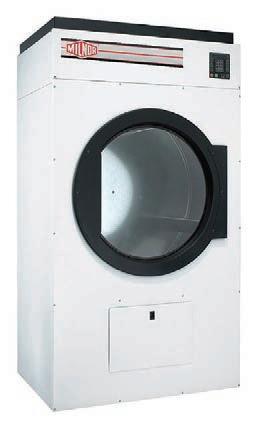
Pellerin Milnor corP. Milnor’s M78 dryer is rated at 75 pounds in capacity, but provides laundry operators with the same cylinder by diameter (44.5 inches) as a larger model, the company says. The large cylinder allows linen, such as sheets, spreads, duvet covers and blankets, to open more fully than it would in a standard 75-pound machine with a 36/37-inch diameter cylinder, Milnor adds.
TRSA Texts, Videos, Research
Resources for Improving Textile Services Productivity, Profitability
SAFETY VIDEOS: Footage of laundry operations and textile services facilities provides needed context for training personnel to comply with precautions, understand safety procedures.
NEW! Managing OSHA Inspections DVD
From readying for an inspector’s visit to contacting OSHA months afterward, how to work with the agency: recognize most common laundry citations, build a team to make your case (assign roles to individual staff), advise employees on interviews, record conversations, prepare documentation. $245 / $495
The most comprehensive training text and resource for laundering all types of linen and industrial soil classifications
Explains basic laundering concepts to guide creation and monitoring of wash procedures; 14 chapters cover wash formulas, chemical use and handling, fibers and fabrics, finishing, energy, trouble-shooting, and more. 396 pages of charts and text.
Members $80 / Non-Members $320
• Precautions for Protection: Handling Soiled Healthcare Linen DVD (English/ Spanish) $100 / $400
• Control of Hazardous Energy: Lockout/ Tagout DVD (English/Spanish) $100 / $400
2012 Textile Services Plant
The dryer also has excellent airflow, typically 20% more than a standard unit (1200 CFM vs. 1000 CFM), the company says. This promotes quicker dry times, which also helps to save on labor costs.
The dryer also features a smaller footprint—it will fit through a 36-inch door—
TEXTILE SERVICES ARCHIVE SERIES: “Best of” collections of articles from TRSA’s award-winning monthly to help operators improve profitability and service
NEW! Textile Services Essentials Compendium of articles from recent decades of Textile Services (formerly Textile Rental) and Industrial Launderer (legacy) selected as most timeless and informative by a panel of industry leaders. Helps operators in every customer market improve profitability and service. $75 / $150
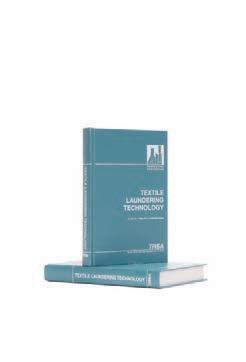
• Healthcare Laundering $75 / $150
• Sustainable Laundering $75 / $150
Order these two reports together for one low price. Members $795 Non-Members $2495
info@trsa.org
www.AmericanLaundryNews.com AmericAn LAundry news | J u Ly 2013 15
Employee Compensation
Benefits
How To Order Online: www.trsa.org/store • Telephone: 877.770.9274 or 703.519.0029 (VISA, MasterCard, AMEX) • By Mail: send check to TRSA, 1800 Diagonal Road, Suite 200, Alexandria, VA 22314 • Fax: 703.519.0026 • Email:
• $10 shipping/ handling for
orders, ask for S/H rates to other countries ALN_Tab_half.indd 1 6/17/13 8:14 AM
RESEARCH / BENCHMARKING Corp.] ➢
&
Report Benchmarking resource allows you to remain competitive with your local market and compare your employment package with textile services operators with similar operations, product mix, sales volume and markets. $495 / $1995 2012 Textile Services Industry Performance Report Gauge productivity, efficiency and financial performance against operators of similar sales volume, number of locations, and product mix and markets (industrial, linen, healthcare, mixed). Glean industry sales and operations trends. $495 / $1995
U.S.
[UniMac] [Pellerin Milnor
and a user-friendly microprocessor control with an easy-to-read display.
Its field-programmable Smart Lint Monitor feature prevents machine operation if the lint drawer has not been cleaned out on a regular basis.
milnor.com 504-712-7656
design boasts double sealed bearings and a quiet belt drive, while the pulleys are made of durable cast iron, according to the company. The large door opens 180 degrees for easier loading and unloading.
The dryer is available with either a dual timer or microprocessor control and optional moisture-sensing technology that saves energy by stopping the dryer when goods are dry. This feature allows for careful handling of delicate goods encountered in the wet cleaning process.
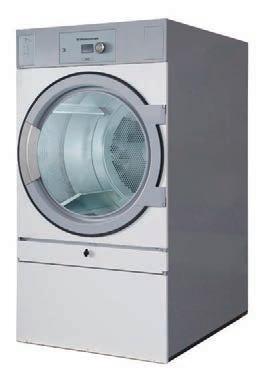
Other options available in the DE line include reversing cylinder and fire suppression. Models are available in natural gas, LP gas, steam and electric heat versions with single- and three-phase electrical voltages.
bandctech.com 850-249-2222
speed Queen
Speed Queen recently upgraded its 55-pound tumble dryer, the ST55, with technologies to help increase efficiency and throughput, the company says.
B&C TeChnologies
B&C Technologies’ DE series dryer offers a wide selection of capacities, heating alternatives and control systems. Available in 30-, 50-, and 75-pound capacities, the DE dryers work well for onpremise laundries and medium to large professional laundries, the company says. The dryers will help boost productivity, save energy, and are safe, reliable and simple to use at an affordable price, B&C adds.
A heavy base frame provides the machine’s foundation, helping to protect it during shipping and installation. Coupled with the painted, enclosed and insulated cabinet, which utilizes heavygauge steel and welded design, the machine is a sturdy addition.
A stainless steel cylinder
The small-capacity tumble dryer is ideal for on-premise laundries because it evenly dries extra-large loads and items, such as king-size comforters, sheets and tablecloths, the company says.
The single-cylinder dryer is now available with reversing technology. This allows the dryer cylinder to alternate directions, preventing large items from knotting and twisting. The action also provides a consistent and even dry. The ST55 helps on-premise laundries increase efficiency because staff will no longer need to unwind laundry or run additional dry cycles, Speed Queen says.
The technology is available through the brand’s Quantum® controls. When equipped with these controls, laundry managers can easily program the tumble dryer, customize settings and receive information on laundry
operations, such as audit data to determine training issues, inefficiencies and more, Speed Queen says.
speedqueen.com 800-590-8872
dexTer laundry
Dexter Laundry recently launched a refresh of the company’s dryer line with a redesign of the onpremise and commercial dryer line.
Recent improvements include heat recirculation to help with gas efficiency and small-load drying, a reversible loading door on OPL models that allows for machine installation on either side of washers, and a hinged lower service door to allow for easier access to lint screen maintenance. All gas and ignition components, along with motor relay, transformer and fuses, are accessible at the rear of the machine, allowing for common troubleshooting.
All Dexter dryers deliver energy efficiency by balancing heat input, tumble speed, air recirculation, and airflow through fully perforated, large-diameter cylinders, the company says. Engineered to handle tough industrial loads, Dexter dryers feature a fully welded solid steel cabinet structure, heavy-duty bearing housings, oversize bearings, as well as hardened steel trunion-shaft assemblies. This “over-built” design gives the machine years of reliable service, the company says.
After a six-stage pre-treat process, each cabinet assembly is painted inside and out for maximum corrosion resistance. The extra-large loading doors are made of stainless steel, which include full-view glass and easy-grip handles. Dexter dryers also feature solid-state microprocessor controls and electronic spark ignition.
Dexter dryers are available in 30- and 50-pound single-pocket capacities. Easy to install, the dryers require only single gas, electrical and exhaust connections.
dexter.com 800-524-2954
series are, according to the company, two to three times more efficient than other cabinet styles with older atmospheric burner technology.
Air re-circulation is a standard feature, increasing overall efficiency and improving finished results with low-energy consumption and lower noise levels, Lavatec Laundry Technology says. Shorter drying times can be achieved with an optional infrared sensor measurement of the linen surface temperature, and a sophisticated dryer control that works in tandem with a specially designed burner.
lavatec-laundry.com 203-632-8777
WasComaT
Wascomat dryers, distributed in North America by Laundrylux, deliver trusted results for years, the distributor says.
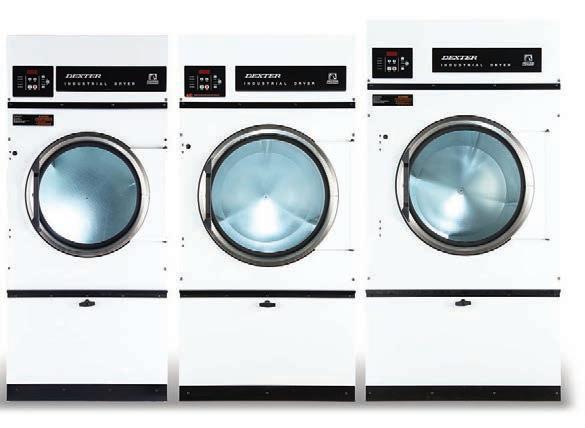
lavaTeC laundry TeChnology
The FL600 series of small dryers from
Technology includes capacities ranging from 25 pounds to 100 pounds, with improved combustion systems and efficient modulating forced draft burners for a shorter dry cycle.
These dryers also are available with steam heating. Durable and productive, dryers in the FL600
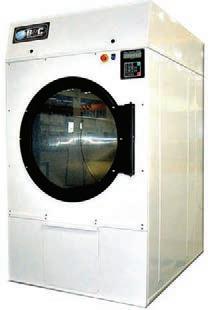

The dryers feature an optimal combination of gas consumption and airflow to help with fast drying and lower energy consumption; large doors to make loading and unloading more accessible; convenient access to all parts; a large lint compartment for easy maintenance; and a reversing drum to help minimize tangling and wrinkling, which improves efficiency and helps make flatwork finishing easier, Laundrylux says.
The machines also feature residual moisture control to help prevent damage to garments caused by over-drying, reducing lint and wrinkling by stopping the dryer when a pre-set moisture level has been reached.
laundrylux.com 800-645-2205

16 JULY 2013 | AmericAn LAUndrY news www.AmericanLaundryNews.com
Lavatec Laundry
ALN
Laundry]
[Speed Queen]
[Dexter
Laundry
Technologies]
[Lavatec
Technology] [B&C
coming Up in AUgUst’s prodUct showcAse: wAter reUse/recYcLing sYstems
[Wascomat]
Principles to consider when choosing distributor partner
By mArk Hynes
UPPER MARLBORO, Md. —
Most on-premise laundry managers understand that their facility is heavily reliant on the equipment and services provided by their distributor. It’s also important to realize how the distributor’s manufacturing partner is involved.
Keeping this in mind, there are a few specific areas that managers should focus on when vetting a potential partner.
STABILITY
Most people wouldn’t trust a first-year law school student to provide legal counsel, so why would managers trust a distributor that hasn’t been established in the community and the OPL business?
If a distributor has supported its clients through the most recent of economic downturns, and sometimes even crises dating back to the Great Depression, managers should be confident in their ability to provide equipment and services to best fit the facility’s needs.
The success of a distributor can be closely tied to the commercial
laundry manufacturer they support. A manufacturer that has been an industry mainstay for many years has been effective in offering innovative equipment that positively impacts the bottom line.
INNOVATIVE AND DURABLE
A distributor should be able to deliver options for durable, commercial-grade equipment that will provide the lowest operating costs.

Manufacturers offer commercial equipment with advanced control systems to increase efficiency and help reduce operating costs associated with labor, linen replacement, utilities and maintenance. These control systems can also provide alerts when preventive maintenance and service is required.
Even with these advanced features, it’s not uncommon for laundry managers to be enticed by equipment with the lowest price tag. Customers who choose the less-expensive machines, that sometimes deploy the same technology found in home equipment, often end up wasting time and money due to frequent repairs and replacement machines.
With this in mind, managers should ask the distributor about the machines’ manufacturing and testing processes.
In addition to sharing basic information such as where the equipment is made, a knowledgeable distributor will be able to provide specifics on these processes.
AFTER THE SALE
It’s important to remember that choosing equipment is just the start of one’s relationship with a distributor. Managers should ask about the service and support they’ll receive after the sale.
By taking part in in-person and online training and certification sessions provided by the manufacturer, distributors are able to offer customers factory-trained service technicians. These technicians will ensure the equipment is maintained and serviced properly throughout its life. If the service area extends across multiple cities or states, distributors should have technicians strategically placed within each territory to be able to provide fast response times.
It’s important for the distributor
to use genuine parts when making repairs, those that are identical to the ones used in the machine at the time of manufacturing. Created by the same team of advanced engineers that both tested and produced the equipment, these parts, available through the manufacturer, will ensure the machines continue to perform at the highest level after service.
TOOLS AND RESOURCES
A quality distributor will be able to add value beyond the equipment and after-sales service and support it provides.
Whether they’re starting from scratch or redesigning a current facility, customers should look to distributors that are able to provide valuable resources including laundry design services and financing options. Once they visit the location and understand the specific needs, a distributor can work with the manufacturer to bring a customer’s vision to life.
A 3-D rendering produced with computer-aided design (CAD) can provide a plan to scale that includes everything from the lay-
out of machines, to the location of cabinets, racks and other equipment necessary for the successful operation of the laundry room.
Should funding assistance be required, it’s important to consider a distributor whose manufacturing partner provides in-house financing. Specifically tailored to meet unique OPL challenges, the team of financial experts provides one-onone service before, during and after the application process, which can often be completed online.
While it may require a bit of due diligence, decision makers must be sure to thoroughly vet the equipment and customer service provided by a distributor and its manufacturing partner. After all, it is only the success and reputation of their facility at stake. ALN
Mark Hynes is the owner of Hynes & Waller, a fourth-generation, family-owned distributor of UniMac® commercial laundry equipment. Hynes serves the Washington, D.C.; Maryland, Virginia and West Virginia area and can be reached at sales@hynesandwaller.com or 800776-9424.
AUGUST
Feature: Eye on Efficiency Finding ways to conserve valuable resources is a never-ending quest for launderers; Clean Show Report Part II An expanded look at the announcements, introductions and ideas that made Clean ’13 a success.
Editorial Submission Deadline — June 15
SEPTEMBER
Feature: Distributors Directory Our audience relies yearround on this annual directory issue listing distributors of laundry equipment, textiles, chemicals and other supplies. You’ll want to hang onto this issue for future reference!
Editorial Submission Deadline — July 15
OCTOBER
Feature: Hotel/Motel Laundering: Providing Five-Star Service We preview the International Hotel, Motel + Restaurant Show and get our readers caught up on the latest hospitality laundry trends.
Editorial Submission Deadline — August 15
NOVEMBER
Feature: What’s Hot in Uniforms We analyze this year’s garment styles and take a peek at what will be hot in 2014; Texcare Asia Preview The popular every-other-year exhibition returns to Shanghai to reach the world’s hottest markets for textile care services.
Editorial Submission Deadline — September 15

ALN_Jr_half.indd 1 6/13/13 3:35 PM IN EVERY ISSUE: • Tools of the Trade • Wire Survey Results • Career Track • Trade Ticker • Panel of Experts • Upcoming Events • Source Directory • Classifieds Want to send a press release or submit a story? Contact Bruce Beggs, editorial director, today! Phone: 312-361-1683 E-mail: bbeggs@americantrademagazines.com HERE’S WHAT’S COMING UP IN AMERICAN LAUNDRY NEWS... ...and much more!
DON’T MISS OUT
0713aln_EditCal_JuniorHalf.indd 1 6/19/13 1:13 PM www.AmericanLaundryNews.com AmericAn LAundry news | J u Ly 2013 17
OPL 101
Speed Queen names Yankee Equipment its 2012 Distributor of Year
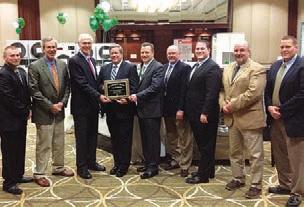
RIPON, Wis. — Speed Queen recently named Yankee Equipment Systems Inc. its 2012 Distributor of the Year during the distributor’s annual customer appreciation event in Waltham, Mass. Yankee Equipment has been selling Speed Queen products for more than 25 years.
“Our distributor of the year award is not only about yearover-year sales increases,” says Dan Bowe, Speed Queen national sales manager. “We recognized Yankee Equipment Systems because of how they represent the Speed Queen brand – their commitment to customer service, their active involvement in the industry and their ongoing investment into their company, including employee training and seminars.”
Yankee embodies the Speed Queen Customer One philosophy, a commitment to customer satisfaction, Bowe adds. The significance of this award is only deepened by the strength of Speed Queen’s 68-distributor network.
“We are honored to receive the Speed Queen Distributor of the Year award, and recognize that it represents an ongo-
ing partnership between our two brands,” says Ted Ristaino, co-owner of Yankee Equipment Systems. “Speed Queen truly partners with their dealers to provide quality products and training to better enable us to service our customers. It helps us keep our brand as fresh and value-oriented as it can be.”
Yankee Equipment Systems distributes Speed Queen products in Connecticut, Maine, Massachusetts, New Hampshire, Rhode Island and Vermont.
Cintas, GK Direct among NAUMD Image of Year winners
SYOSSET, N.Y. — The Walt Disney Co., Cintas and GK Direct were among those honored recently at the North American Association of Uniform Manufacturers & Distributors’ (NAUMD) 2013 Image of the Year (IOY) Awards. Since 1978, the annual competition has honored excellence in the design and wear of image and corporate apparel programs.
The award is sponsored by the Image Apparel Institute, a division of NAUMD, and its 16 winning programs are selected by an independent panel of judges from the fashion industry, including celebrated designers, journalists and fashion authorities.
“From polo shirts to custom suiting, apparel designs have a substantial impact on how a customer views a business,” says Richard Lerman, NAUMD president and CEO. “In fact, a recent study revealed that 70% of the public believe that uniforms make employees look neater and more professional. This award recognizes the businesses that have made employee appearance and guest satisfaction a priority.”
This year’s winners, by category, were: Hotels—Single Unit — Grand Hyatt San Francisco, Cintas, supplier; The Disneyland Hotel, The Walt Disney Co., supplier.
Hotels—Multi-Unit Marriott Corp.’s “Red Collection,” Cintas, supplier.
Restaurants—Fine Dining — The Breakers, Cintas, supplier.
Restaurants—Quick Service — Flo’s V-8 Cafe, The Walt
Disney Co., supplier.
Service & Industry — Toyota Motor Manufacturing, GK Direct, supplier.

Transportation—Services Con-Way Freight, Arrow Uniform, supplier.

Transportation—People Air-North Yukon, Omega Uniform Systems, supplier.
Healthcare Ottawa Hospital, Unisync Group Ltd., supplier.
Casinos — Zarkana, Red the Uniform Tailor, supplier.
Entertainment Delaware North Co., Superior Uniform Group, supplier.
Retail Establishments — Price Chopper, Superior Uniform, supplier.
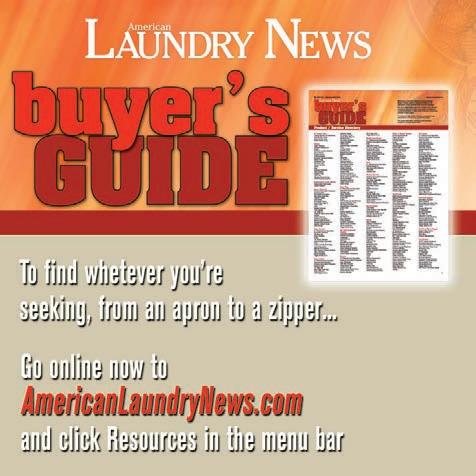
Retail Establishments/Non-Food — Rexall, Unisync Group Ltd., supplier.
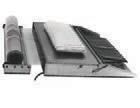
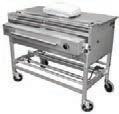
Community Service — City Year, Aramark Uniform, supplier; Girl Guides, Unisync Group Ltd., supplier.
Special Recognition — Mary Kay 50th Anniversary, GK Direct, supplier.
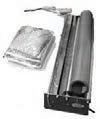
Paris Companies achieves ‘Top 100 Organizations’ three-peat
DUBOIS, Pa. – For the third consecutive year, uniform and healthcare linen services company Paris Companies has been named one of the “Top 100 Organizations” by Pennsylvania Business Central magazine. The company has received the distinction a total of four times: 2008, 2010, 2011 and 2012.
More than 70,000 organizations entered the magazine’s annual competition, where it selects recipients based on results, performance and awards, according to Paris.
The company operates facilities in DuBois, Harrisburg, Pittsburgh and Williamsport, Pa.; Olean, N.Y.; and Ravenna, Ohio, and staged celebratory events at each in honor of the distinction.
CEO Dave Stern credits much of the company’s success to its employees.
“I credit this honor to the fact that Paris Companies is a growing company, creating opportunities for all,” says Stern.
18 juLY 2013 | AmericAn LAundrY news www.AmericanLaundryNews.com
Yankee Equipment Systems and Speed Queen gather
the
and Film Solutions www.davispackaging.net - contact@davispackaging.net Phone: 800.622.3015 - Fax: 561.739.6167 Protect cleaned laundry from folding to delivery Models for any need: Commercial, Industrial, Coin-Op, Hospital, Rental Compact designs save floor and table space Laundry wrap available in all standard sizes - no minimum orders Repair & replacement parts for all Davis and competitor models ♦ TD362 Deluxe ♦ 36”Mini Bundler ♦ Std▪HD▪xHD Wrap ♦ 36” Table Top Wrap like a PRO… Affordable, Professional, Easy to Use Laundry Wrapping Equipment & Supplies Clean Show discounts extended through July 31 ALN_3rd Page.indd 1 6/4/13 4:18 PM
Representatives of
for
award
presentation: (from left) Tom Carney, Mike Webb, Ted Ristaino, Jay McDonald, Peter Limoncelli, John Smith, Brendan Ristaino, Gerry Guertin and Mike Buck.
“Even more important, Paris Companies stands out among other businesses because of its employees. Every person who works for Paris Companies is responsible for the success we have achieved.”
The lineup of speakers includes:
• Simon T. Bailey, founder of the Brilliance Institute, who will deliver the keynote address, Own the Moment – How to Become a Brilliant Leader.
Calendar

CINCINNATI — Standard Textile Co. has been named a recipient in Interactive Health’s 2012 annual “Healthiest Companies in America” awards.
A total of 72 honorees from various states were awarded with the distinction, with Standard Textile among the seven selected from Ohio.
In its sixth consecutive year, the award highlights companies that have made employee health a priority, and have created a culture of health in the workplace through outcomes-based health management programs.
Recipients are chosen through clinical test results demonstrating improved employee health across an index of key health indicators, according to Interactive Health, who provides outcomes-based health management programs for organizations.
Joseph A. O’Brien, president and CEO of Interactive Health, commended this year’s recipients, saying that earning the distinction takes “corporate courage and commitment.”
A world-renowned speaker, thought leader, and best-selling author, Bailey believes that it is the responsibility of each person to unlock the true brilliance that is buried deep within. Experience gleaned in leadership roles with organizations like the Walt Disney Co. helped him foster an in-depth understanding of the formidable challenges, pressures and risks that organizations face.
• Stephen M. Brecher, Ph.D., director of microbiology, VA Boston Health Care System, will deliver From Tragedy to Triumph to Trepidation: Antibiotics at Age 70.
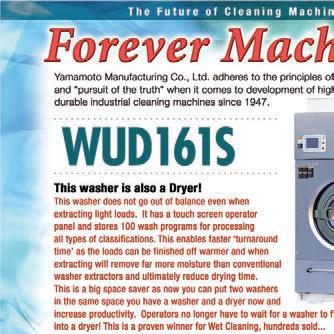
Brecher is a highly acclaimed international speaker who covers many topics, but his preferred topics are C. difficile infections and antibiotic resistance.
• Colleen Sweeney, R.N., founder and owner of Sweeney Healthcare Enterprises, will deliver What Patients Fear and Why We Have to Know.
Sweeney conceived and conducted the Patient Empathy Project SM, which resulted in the development of the Patient Experience Pyramid SM, a tool for healthcare teams to uncover and respond to patient fears. Her most recent position was as director of ambassador and customer services at Memorial Hospital in South Bend, Ind.
July
18 Association for Linen Management Manager Series Webinar: Building a Successful Linen Quality Assurance Program Info: 800-669-0863
23-24 Textile Rental Services Association Textiles Summit Waldorf-Astoria, New York, N.Y. Info: 703-519-0029, ext. 108

25 Textile Rental Services Association Executive Roundtable — Hospitality (Hotel & Lodging) Waldorf-Astoria, New York, N.Y. Info: 703-519-0029, ext. 108
31-3 Textile Care Allied Trades Association Annual Management and Educational Conference Rancho Bernardo Inn, San Diego, Calif. Info: 973-244-1790
August
CHICAGO — The Association for the Healthcare Environment (AHE) of the American Hospital Association has announced its lineup of keynote speakers and general sessions at EXCHANGE 2013, scheduled for Sept. 15-18 in Indianapolis.
New this year to EXCHANGE are presentations by Patti Costello, executive director, AHE; Greg May, CHESP, director of environmental services, linen and sustainability initiatives, UC San Diego Health System; and Christopher Ridenhour, director, Core Competency Training, Liberty Lutheran, Ambler, Pa.
EXCHANGE is an annual educational event attended by approximately 900 professionals with an interest in caring for healthcare environments. To learn more about the event, visit ahe.org/exchange ALN
11-15 Textile Rental Services Association Executive Management Institute University of Maryland, College Park Info: 703-519-0029, ext. 108
15 Association for Linen Management Manager Series Webinar: Zero Waste Stream Info: 800-669-0863

25-29 International Association for Healthcare Textile Management 2013 Annual Member Meeting Banff Springs Resort,
Banff, Alberta, Canada Info: iahtm.com
29 Association for Linen Management Technician Series Webinar: Role of Team Leaders/Supervisors Info: 800-669-0863

September
15-18 Association for Healthcare Environment EXCHANGE 2013 Indianapolis (Ind.) Convention Center Info: 312-422-3860
16 Association for Linen Management Manager Series Webinar: Coaching Staff to Save Money... Info: 800-669-0863
18-19 Wisconsin Association of Textile Services Fall Conference and Golf Outing Lake Lawn Resort & Spa, Delavan, Wis. Info: 414-529-4702
22-25 Textile Rental Services Association Annual Conference Fairmont Sonoma Mission Inn & Spa, Sonoma, Calif. Info: 703-519-0029, ext. 108
29-2 Independent Textile Rental Association Annual Convention Silverado Resort and Spa, Napa, Calif. Info: 706-637-6552
www.AmericanLaundryNews.com AmericAn LAundry news | juLy 2013 19
ALN_3rd Page.indd 1 5/10/13 10:05 AM
ALN
Standard Textile named one of ‘Healthiest Companies in America’
AHE announces speaker lineup for EXCHANGE 2013 conference
REPUBLIC TEXTILE EQUIPMENT CO. OF SC, INC.

10 Braun Dye Machines, 600 lb. capacity each, 480 volt, 3 phase, 60 cycle, with steam injection, 2 pocket (8 Model 600NTDPV, year 1990-1995 / 2 Model 600NTDPY-3-DC, year 1999)
1 Braun 400 Lb. Dryer, S/N H8193146, Model 81H-NGF, year 1993, stainless steel basket, 480 volt, 3 phase, 60 cycle, gas fired, single door in the front, has Braun control
1 UniMac Dryer, Model UT-170, S/N 1009001564, 170 lb. capacity, gas fired, with Monel stainless steel basket, Inside dimensions: 41” deep x 51” dia., computer control, 240 volt vac, 3 ph, 60 hz, 13.5 amp
1 Uniwash Sample Dye machine, Model UW125P4, S/N 125790, 100-125 lb. capacity. 208/240 volt, 60 hz, 3ph, 26 amp, Max. water pressure: 150 psi, Max. air pressure: 125 psi, Max. steam pressure: 125 psi
1 UniMac Sample Dye machine, 1015 lb. capacity, 208 volt, 3 ph
1 UniMac lab dye machine, Model UW35PF2, S/N 000350949, D System controls, 35 lb. maximum capacity, 208/240 volt, 60hz, 3 ph, 7 amp
PLEASE CONTACT US ABOUT YOUR EQUIPMENT NEEDS 803 684-2321 republic@republictextile.com
PARTS, PARTS, PARTS
Huge stock of parts for most laundry equipment & boilers.
Also traps, valves and lubricants. Overnight delivery.
Steiner-Atlantic, 800-333-8883 Fax: 305-751-8390 parts@steineratlantic.com www.steineratlantic.com

WASHEX PARTS
Hard-to-find Washex parts, on-site rebuilding, tech support.
LAUNDRY PARTS CENTER 800-352-4492 Fax: 305-827-3991
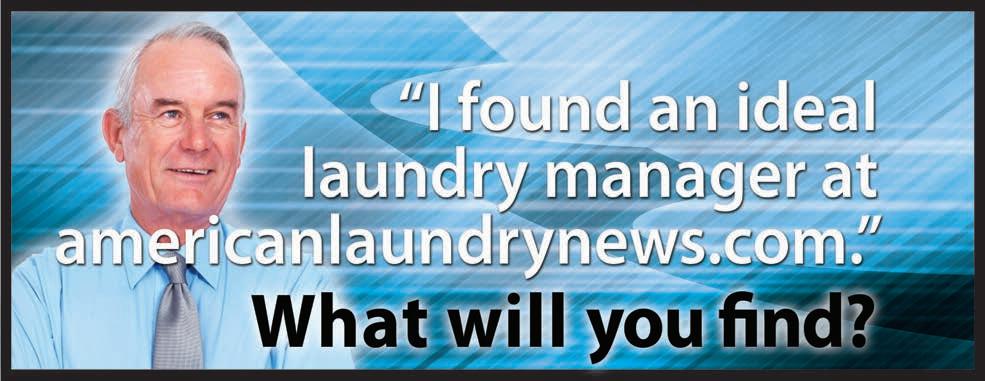

20 JUly 2013 | AmericAn lAUndry news www.AmericanLaundryNews.com www.cornerstonemachinery.com Quality used and reconditioned equipment Rigging and relocation services Satisfaction guaranteed Complete inventory on our website Please call or email John or Eric eric@cornerstonemachinery.com 877-773-1850
classified Advertising www.directmachinery.com For pricing, please call Ron Hirsch (516) 938-4300 Office • (516) 315-7426 50 Commerce Place • Hicksville, NY 11801 Fax (516) 932-8095 QTY DESCRIPTION Excellent Preowned equiPment WILL SELL QUICKLY 1 Milnor 30022V6J 60lb Washer with Steam Injection 2 Milnor 120lb Steam Dryers 2006 1 Shaper Steam 12” Ironer by 120 1 Milnor 110lb Soft Mount 2000 1 Air Chicago XL Blanket Folder/Small Piece Folder 1 Chicago Comet Ironer 1 Wascomat Soft Mount 30lb Washer 1 Wascomat Soft Mount 50lb Washer 2 Milnor 42026V6J 140lb Washer 2006 with Steam 1 Cissell 150lb Gas Fired Dryer 1 Sharper SF1200 Steam 120” Ironer Pictures are on Website DIRECT MACHINERY SALES CORP. pArts for sAle eqUipment for sAle eqUipment for sAle AMKO AMERICA, INC. Remanufactured Finishing Equipment Delta Ironers, Omega Folders & Towel Folders (1 year parts warranty) Like new at half the cost. PARTS, IRONER SUPPLIES & NEW EQUIPMENT ALSO AVAILABLE Contact: (561) 863-9696 jurgenb@bellsouth.net Call Craig Lloyd toll free at (877) CWL-LOYD between 9 a.m. – 9 p.m. EST. Please visit www.laundrycareers.com to review current industrial/institutional laundry management openings. ADVANCE YOUR CAREER positions AvAilAble www.ineedjpequipment.com 1-800-925-3236 J.P. EQUIPMENT INC. We will buy/sell/trade EQUIPMENT FOR SALE: (1) 2006 Chicago Tristar 24 (1) Jensen 1-Roll Steam w/Folder Stacker (1) Ellis Pump (Rebuilt) for 900lb 1 yr warranty 400lb Steam Dryer (1) 2010 Chicago King Edge 136” Wide New Condition w/vac (1) Jensen 5-Lane Drape and Store (1) Braun 2-Roll 48” Steam Ironer Perfect Condition (1) 200lb Braun OP Rebuilt (1) 400lb Braun OP Rebuilt (1) Milnor Tunnel Systems We’ll install – Call for Quote (1) 2003 King Edge with Vac (2) 2010 King Edge w/o Vac (1) 2005 Chicago Fast Trac Feeder Great for King Sheets (1) Conveyor 30’ Long x 30” Wide (5) Fiberglass Lint Traps (2) 200lb Braun TSL We want your used equipment, please call or e-mail. “Why buy new when you can trust our used” Stanco Industries, Inc. Serving The Textile Trades Since 1970 stanco2626@aol.com 260-420-1232 Fax Visit Our Website: www.stancoind.com -------------- Equipment For Sale -------------2-SUPER SYLON 8-Roll. All Options 2004 Braun 4-Station Spreader 2002 Jensen Variant Spreader 2001 Chicago King Edge Spreader Feeder 2004 Chicago 32” Thermal Ironer 1-Roll 1994 BB&D 5-Lane with 1/2 Fold option 2000 Challenge 600# Gas 2-Door 1999 Chicago Air Folder (4 available) 2000 UniMac 85# w/e 1992 Braun 440# 2 Door Gas Dryer 2002 Ipso 100# Washer/Extractor 1995 Milnor 550# Open Pocket W/E 1992 Washex 250# Open Pocket ------- BOILERS • WATER HEATERS • CARTS Stanco Industries, Inc. 800-932-3769 Serving The Industrial Trades Since 1970 Place your ad online: www.Americanlaundrynews.com MISSED OUR DEADLINE? PART-TIME/FT SALES REPRESENTATIVE Importer of Institutional Linen goods desires sales person with textile sales experience to textile rental, commercial, healthcare and hospitality laundries. Excellent commissions, all territories available Call Sam 800-693-5426 or e-mail: skahen@royalblueintl.com
distribUtor offerings The Griffin Group, Inc. “Recruitment Specialist” All positions available in the Rental Uniform/Textile Industry Call Deana Griffin 888-235-2365 www.thegriffingroup.cc deana@thegriffingroup.cc ®
Sani Wash - McClure Industries, Inc. 9051 SE 55th Ave., Portland, OR 97206 800-752-2821 www.mcclureindustries.com, info@mcclureindustries.com









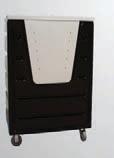






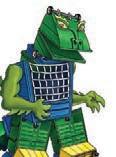
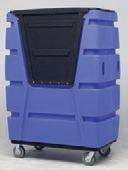





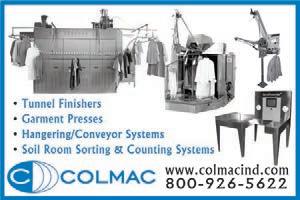

www.AmericanLaundryNews.com AMERICAN LAUNDRY NEWS | JULY 2013 21 Source Directory A convenient guide to sources of products and services APPAREL FINISHING CARTS, TRUCKS & BASKETS Energenics Corp., Kartwasher
Don
CHEMICALS/INJECTOR SYSTEMS Gurtler Industries,
LaSalle
South Holland,
Pellerin Milnor Corp.
LA
DRYERS – 100 POUNDS OR MORE Pack 25% More On Same Size Cart Call 800.829.4535 or visit MODLaundry.com for a FREE QUOTE. Premium Quality Casters Included! 72S Meese Orbitron Dunne Co. Stronger design for big payloads, yet lighter tare weight for easy handling. The Best of Both Worlds Source Directory listings in American Laundry News are sold on an annual basis at the following rates: All Major Credit Cards Accepted 2013 Listings Regular Boldface All Caps All Caps, Boldface Four Line Listing per Year $790 $990 $990 $1,050 Display and additional line rates available upon request CART-WASHING SYSTEMS Sani Trux - McClure Industries, Inc.
SE 55th Ave., Portland, OR 97206
info@mcclureindustries.com M.I.T. POLY-CART 211 CENTRAL PARK WEST, NEW YORK, NY 10024 800-234-7659, FAX: 212-721-9022 WWW.MITPOLYCART.COM CARTS, TRUCKS & BASKETS CARTS, TRUCKS & BASKETS Pellerin Milnor Corp. P.O. Box 400, Kenner, LA 70063 504-467-9591, Fax: 504-468-3094 www.milnor.com DRYERS – 100 POUNDS OR LESS Rotational Molding, Repair, Recycling...Your Complete Plastic Solution 11744 Blue Bell Rd. Elberfeld IN 47613 800-304-4600 www.fibertechinc.net Diversified Plastics, Inc. 1309 Highway 917 West, Latta, SC 29565 800-768-7636, www.dpirotocarts.com E-mail: sales@dpirotocarts.com, Fax: 843-752-7798
1470
St., Naples, FL 34104 800-944-1711 www.energenics.com
Inc. 15475 S.
St.,
IL 60473 800-638-7300, Fax: 708-331-1210 www.gurtler.com
P.O. Box 400, Kenner,
70063 504-467-9591, Fax: 504-468-3094 www.milnor.com
9051
800-752-2821 www.mcclureindustries.com,

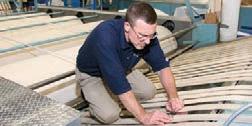







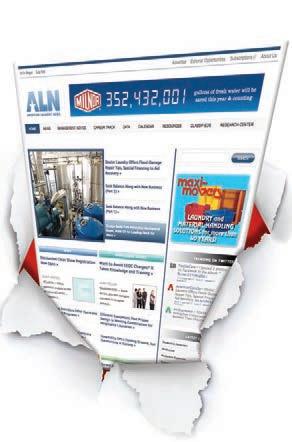






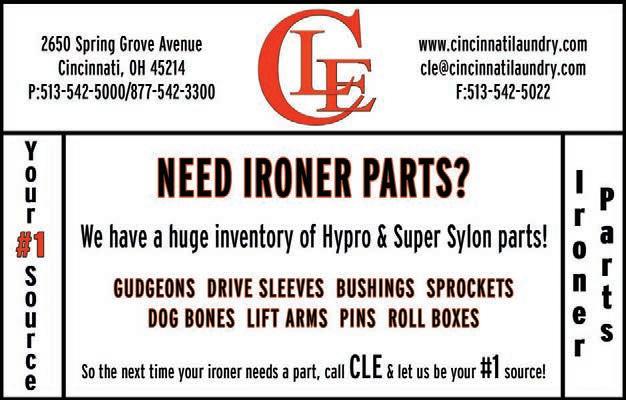
22 JUly 2013 | AmericAn lAUndry news www.AmericanLaundryNews.com Source Directory listings in American Laundry News are sold on an annual basis at the following rates: All Major Credit Cards Accepted 2013 Listings Regular Boldface All Caps All Caps, Boldface Four Line Listing per Year $790 $990 $990 $1,050 Display and additional line rates available upon request source directory A convenient guide to sources of products and services FlATwOrK irOners FlATwOrK irOners Setting the Standard in Lint Filters for 25 Years • Hotel • OPL • Coin Op • Dry Cleaners • Industrial • Commercial • Cruise Industry Dry or Wet Style Filters to Work with “ALL” Dryer Sizes or Multiple Situations, Fiberglass or Stainless and Custom for Unique Situations! All manufacturing done on premise 800-826-1245 www.cleancyclesystems.com • ccsystems@tqind.com pArTs 800.829.3864 www.Tingue.com KnowhowInAction TALLEY M ACH INERY YourTinguerepisafullytrainedmasteroffinishingequipment operation,maintenanceandinstallation.Callfor: •Pads,covers,belts,waxes,tapesandmore •Carts,trucks,basketsandbags •Parts,rebuildsandrepairs Tingue_Knowhow_3x3_ads:Layout 1 2/12/10 12:05 PM Page 1 HeAT seAling sUpplies/TApe linT cOllecTOrs & FilTers H Our In-Line Lint Filter mounts inside, saves space! H Fiberglass Wet Filters - 6,000 to 40,000 cfm H Fiberglass or Stainless Steel Dry Filters ENERGENICS CORPORATION Talk with our Design and Engineering Staff about your needs. Hundreds Sold Annually. 800-944-1711 www.energenics.com Get the info you need online... AmericanLaundryNews.com pArTs C & W EQUIPMENT (800) 443-3573 FLATWORK IRONER SPECIALISTS REMANUFACTURED IRONERS: Super Sylon Sylon Hypro’s Super Pro Jensen SS700 SS800 Ultima Lavatec UPGRADE KITS: Chain Drive Conversion Vacuum Systems Herringbone Conversion Canopies Inverters Side Covers Roll Springs Jensen Drives SUPPLIES: Aprons Pads Covers Belts Waxes Cleaners PARTS/REPAIRS: All Brands New/Refurbished/Hard to Find COMMITTED TO EXCELLENCE Your Ad Should Be Here
Pellerin Milnor Corp.
P.O. Box 400, Kenner, LA 70063 504-467-9591, Fax: 504-468-3094 www.milnor.com
TyinG mAcHines
Felins UsA, inc. Milwaukee, Wi Tying, Banding & Automated shrink Wrap systems 800-843-5667 sales@felins.com
Pellerin Milnor Corp.
P.O. Box 400, Kenner, LA 70063 504-467-9591, Fax: 504-468-3094 www.milnor.com
wAsHer-eXTrAcTOr
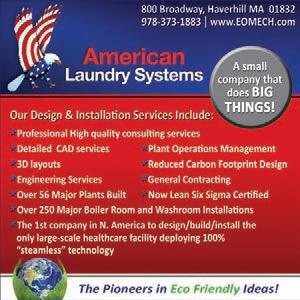
Pellerin Milnor Corp.
P.O. Box 400, Kenner, LA 70063 504-467-9591, Fax: 504-468-3094 www.milnor.com
Pellerin Milnor Corp.

P.O. Box 400, Kenner, LA 70063 504-467-9591, Fax: 504-468-3094 www.milnor.com

www.AmericanLaundryNews.com AmericAn LAundry news | J uLy 2013 23
– 100
POunds Or Less
wAsHers – cOnTinuOus BATcH
– 100
For more information visit us at www.felins.com wAsHer-eXTrAcTOr
POunds Or mOre
Presses – eXTrAcTiOn source directory A convenient guide to sources of products and services PLAnT
& insTALLATiOn Source Directory listings in American Laundry News are sold on an annual basis at the following rates: All Major Credit Cards Accepted 2013 Listings Regular Boldface All Caps All Caps, Boldface Four Line Listing per Year $790 $990 $990 $1,050 Display and additional line rates available upon request company web site Page company web site Page INDEX OF ADVERTISERS American Dawn www.americandawn.com 5 American Dryer Corp. www.amdry.com 9 Cornerstone Equipment & Rigging www.cornerstonemachinery.com 20 Davis Packaging www.davispackaging.net 18 Direct Machinery Sales Corp. www.directmachinery.com 20 G.A. Braun www.gabraun.com 13 The Griffin Group, Inc. www.thegriffingroup.cc 20 Hamilton Engineering www.hamiltonengineering.com 17 IPSO www.ipso.com 11 J.P. Equipment www.ineedjpequipment.com 20 LaundryCareers.com www.laundrycareers.com 20 Lavatec Laundry Technology www.lavatec-laundry.com 24 LG www.lgcommerciallaundry.com 3 NATCO www.nationalcombustion.com 19 TRSA www.trsa.org 15 Stanco Industries www.stancoind.com 20 Yamamoto www.yamamotolaundry.com 19 THE WIRE The latest news, straight to your inbox, 2X a week
desiGn
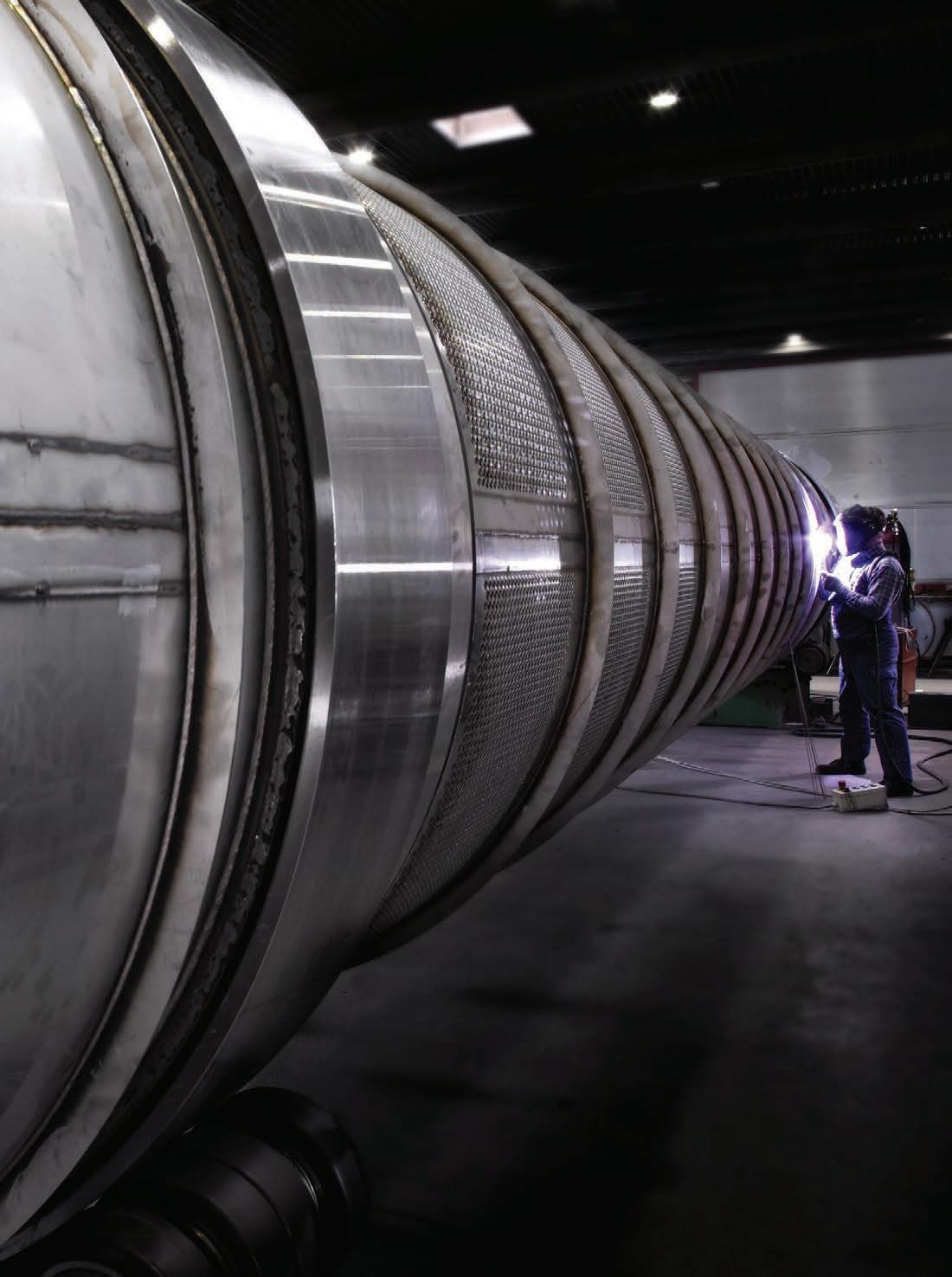
BECAUSE TUNNELS ARE LONG-TERM INVESTMENTS, LLT BUILDS THEM TO HANDLE THE TOUGHEST JOBS FOR DECADES.
of
operate,
ENGINEERED FOR A HIGHER RETURN www.lltusa.com 203.632.8777
With LLT, you get the kind
forethought and execution that can bring to your laundry the exact kind of tunnel it needs. A tunnel that’s simpler to
maintain and retro-fit. A tunnel with versatility to handle up to 95 wash programs. A tunnel with the intelligence to minimize water, energy and chemical consumption. A tunnel with the muscle to handle high temperatures and long hours for decades of productivity with minimal service.





















































































































